YOUNG SCIENTISTS' FORUM
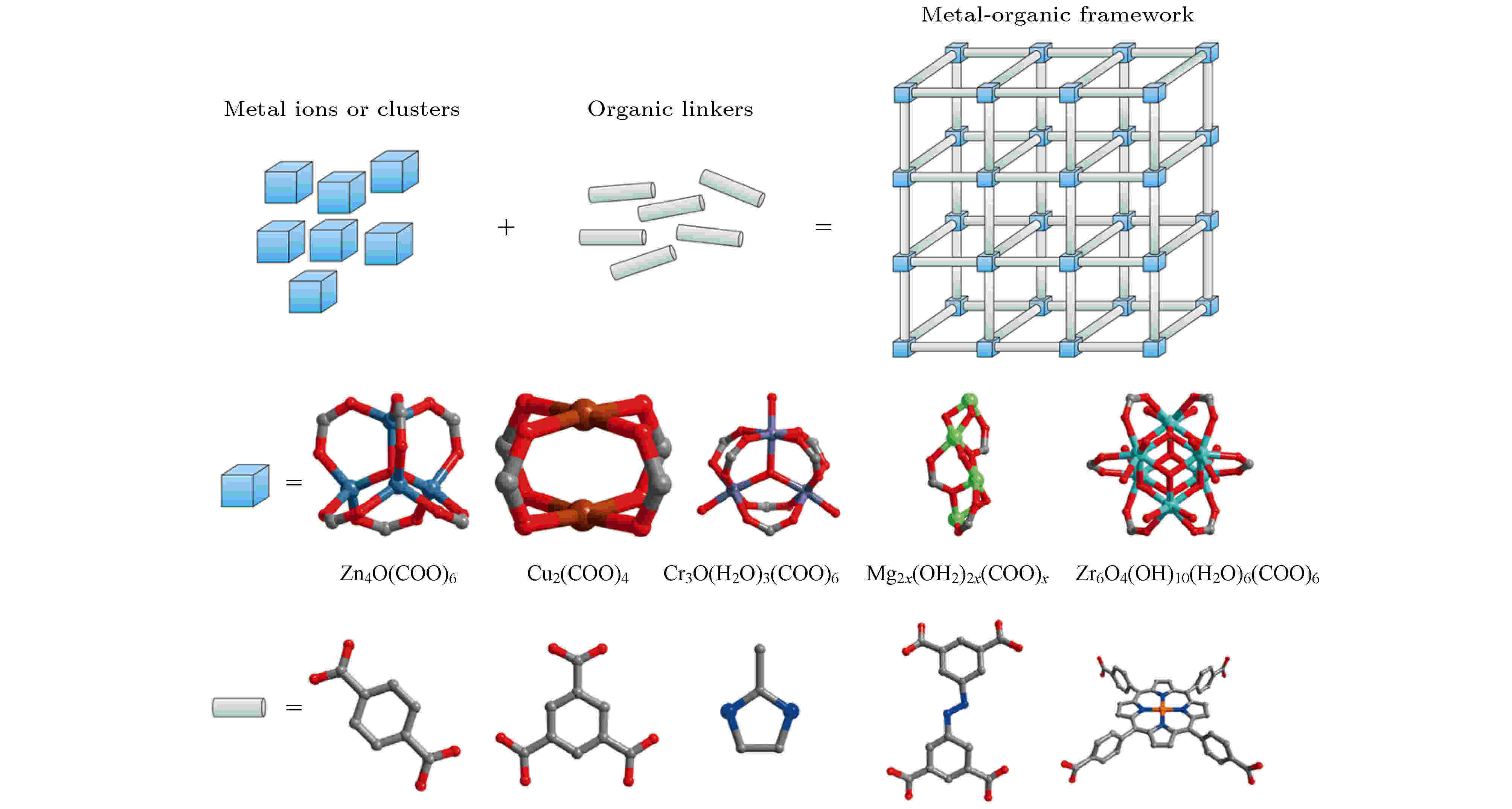
YOUNG SCIENTISTS' FORUM
2020, 69 (12): 126801.
doi: 10.7498/aps.69.20200274
Abstract +
Metal-organic framework (MOF) is a new kind of inorganic-organic hybrid porous ordered crystal material, which is connected by metal nodes and organic ligands through coordination bond. Because of its large specific surface area, high stability, diverse structure and adjustable function, MOF has received wide attention. The improvements in preparation and functionalization of MOF thin films expand their application fields. In this paper, the method for assembly of surface coordinated metal-organic framework thin films (SURMOF) by liquid phase expitaxial layer-by-layer dipping method is introduced, and the physical properties of some SURMOFs in optics, electricity and other aspects are summarized, and the application prospect of SURMOF is prospected as well.
SPECIAL TOPIC—Dielectric materials and physics

2020, 69 (12): 127702.
doi: 10.7498/aps.69.20200311
Abstract +
Spin topologies, including flow-closure, vortex, meron, skyrmion and other spin configurations, are usually found in magnetic materials. The emergence of the topological structures will trigger a number of intriguing functionalities and physical properties. Recent studies have shown that the trival domain structures can be transformed into polar topological domain structures under certain boundary conditions, such as size-confining, interfacial coupling, and epitaxial strain. In this paper, we review the observations of polar topologies and their formation mechanism in ferroelectric nanoparticles, thin films, and superlattice films, and focus on the intriguing properties, including ferroelectric, piezoelectric, dielectric, and photoelectric performances, which arise from the formation of polar topologies. We also review the highlights of recent studies of the manipulations and evolutions of polar topologies under the external field loading in ferroelectric materials. Finally, the future research directions of polar topological structure and potential application directions are proposed.
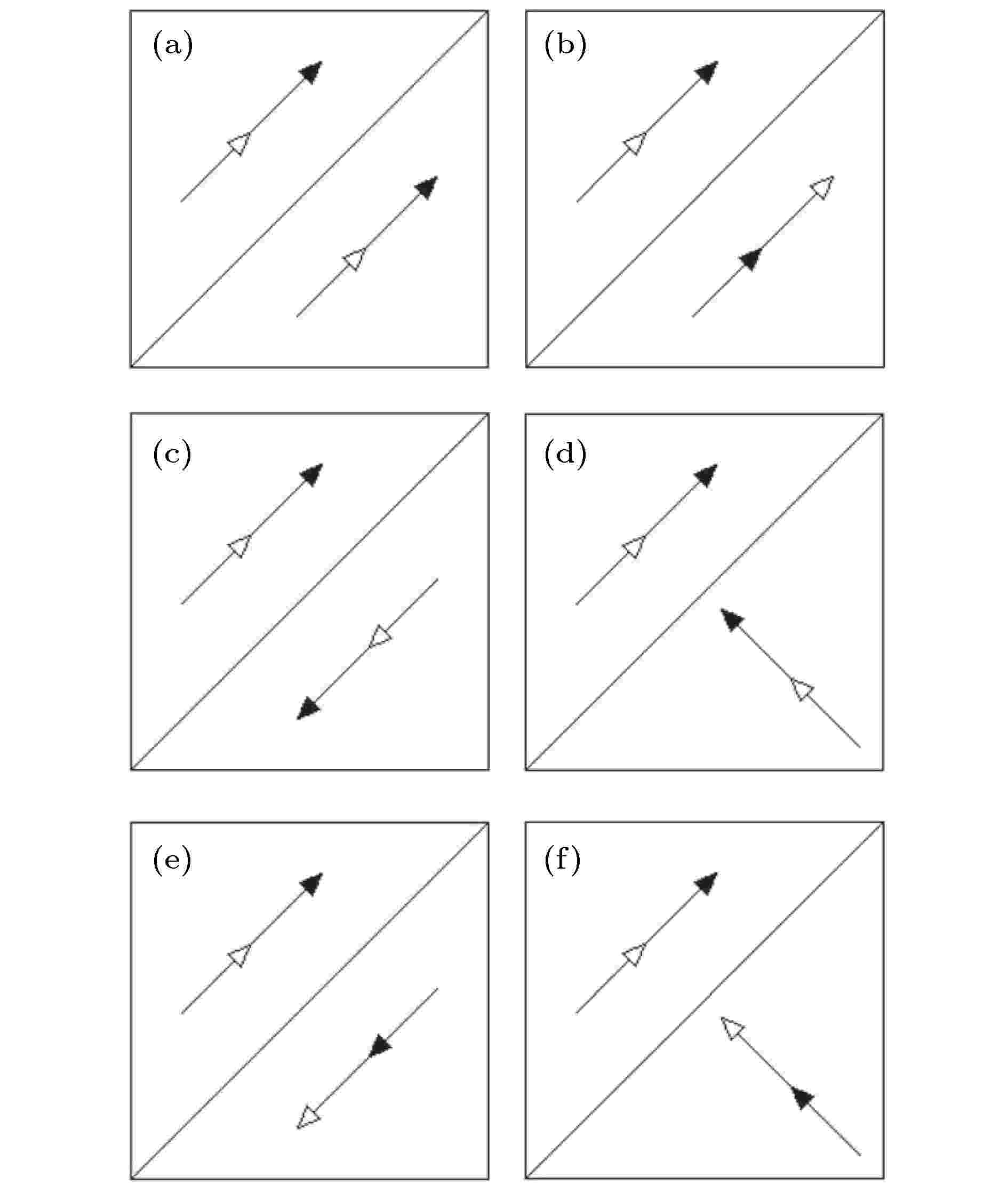
2020, 69 (12): 127704.
doi: 10.7498/aps.69.20200312
Abstract +
Ferroelectric materials with domains being the basic microstructures, have been investigated for about 100 years. With the development of the material fabrication method and the characterization technique, the important influence of domain configuration on the physical properties of ferroelectrics becomes more and more prominent. Recent researches even reveal that the domains and domain walls can act as individual functional units of micro-nano electronic devices, possessing wide potentials in the areas of information storage, energy transformation, electro-mechanical drive, quantum computation, etc. In this paper, starting from group theory analysis of domain structures, we introduce first the formation and the structures of ferroelectric domains, and then the macroscopic mechanical spectra as well as the electrical properties of the ferroelectric materials. Finally, the recent research progress of polarization switching and domain characterization by piezoresponse force microscopy are also reviewed.
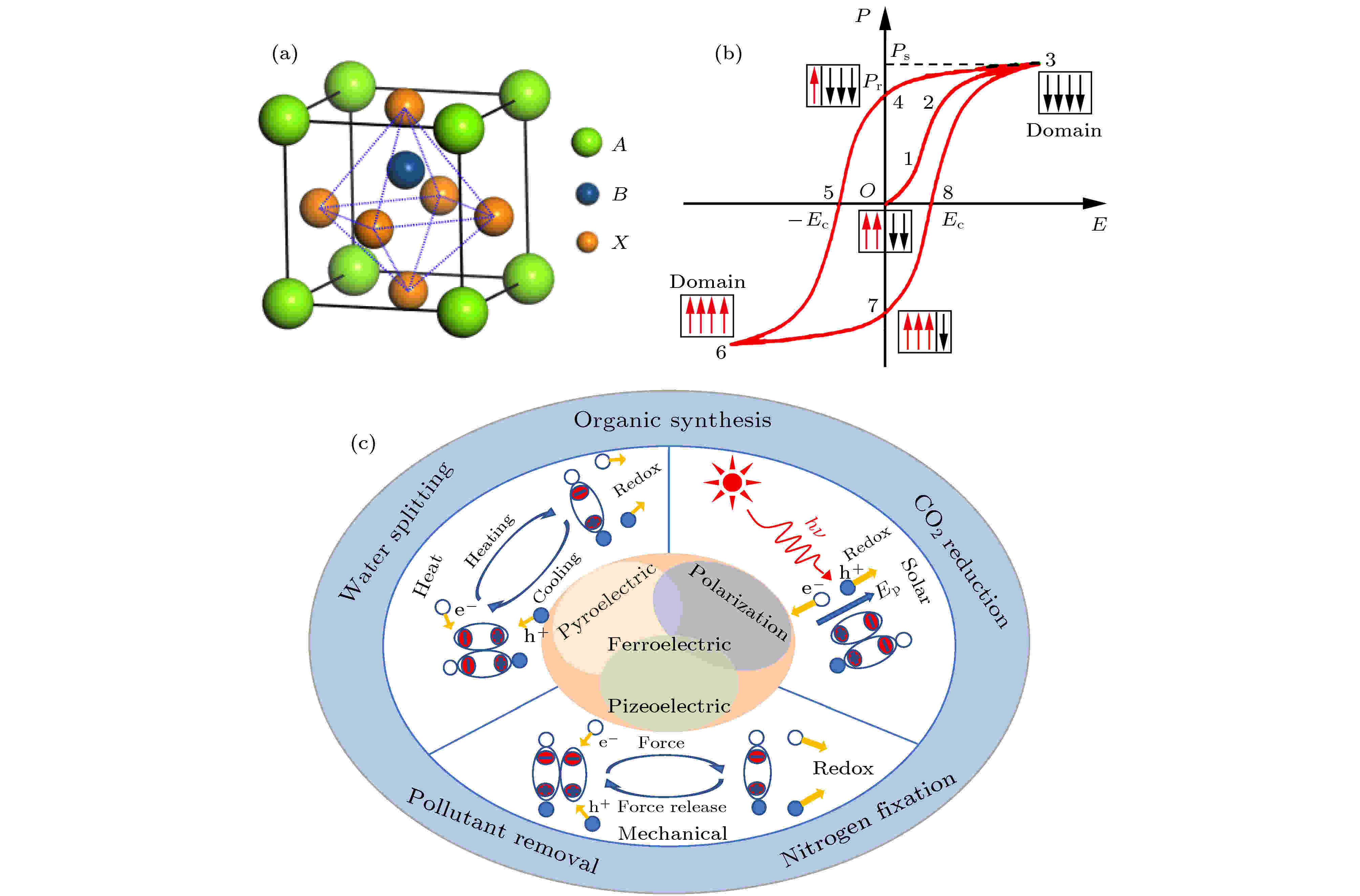
2020, 69 (12): 127706.
doi: 10.7498/aps.69.20200287
Abstract +
There are two types of perovskites, i.e. ABO3-type oxides and ABX3-type (X = F, Cl, Br and I) halides. Both of them exhibit rich physical properties and excellent photoelectric properties, such as ferroelectric and photocatalytic properties. In this paper we introduce the methods of preparing the ferroelectric semiconductors (i.e. BiFeO3 and
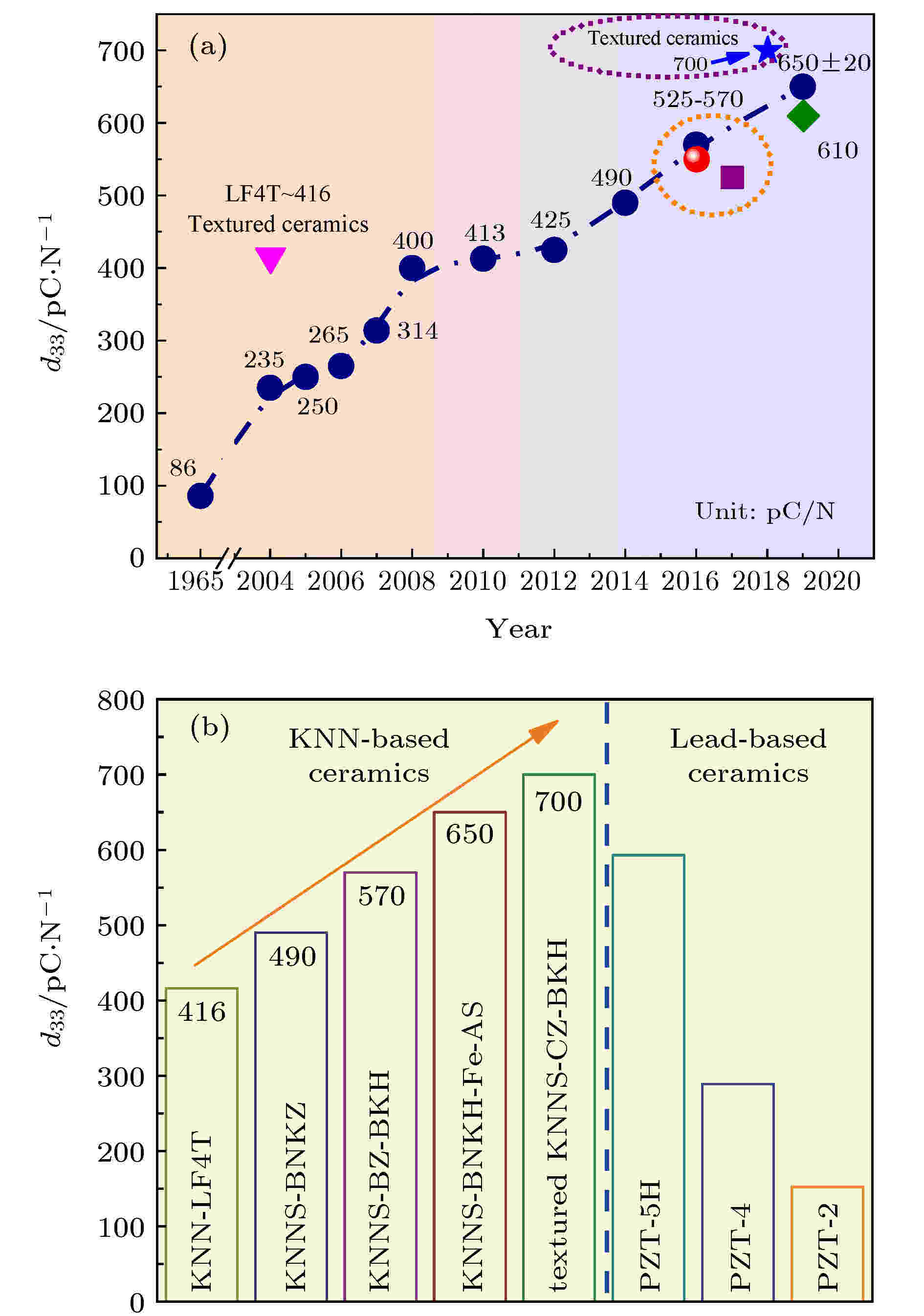
2020, 69 (12): 127707.
doi: 10.7498/aps.69.20200288
Abstract +
Due to excellent piezoelectric properties and electromechanical coupling properties, lead-based piezoelectric ceramics represented by lead zirconate titanate Pb(ZrxTi1–x)O3 (PZT) are widely used in science and technology, industry, military and daily life. However, the content of Pb in PZT-based ceramics exceeds 60% (mass ratio), which will cause serious damage to human ecological environment in the process of their production, use and waste treatment. Therefore, the development of lead-free piezoelectric ceramics has become one of the hot research spots. Potassium sodium niobate (K0.5Na0.5)NbO3 (KNN) lead-free piezoelectric ceramics are considered as one of the most promising material systems to substitute for lead-based piezoelectric ceramics because of their good piezoelectric properties and higher Curie temperature. Through many years of researches, the piezoelectric properties of modified KNN based lead-free piezoelectric ceramics have approached to or even exceeded those of some lead-based piezoelectric ceramics. Combining with our relevant work, we comprehensively review the research progress of high piezoelectric activity of KNN based lead-free piezoelectric ceramics, especially focus on the research progress of high-performance potassium sodium niobate lead-free piezoelectric ceramics, preparation technology and related theoretical mechanisms. The future research direction and prospect of KNN-based lead-free piezoelectric ceramics are also presented.

2020, 69 (12): 127708.
doi: 10.7498/aps.69.20200303
Abstract +
Due to the excellent pyroelectric properties, ferroelectric ceramics containing lead element are widely used as sensitive materials in pyroelectric infrared detectors at present. The research and development of lead-free ferroelectric ceramics for this kind of detector has become a hot research spot in the areas of dielectric physics and materials in recent years. In this article, the recent research progress of the pyroelectric effect in series of important lead-free ferroelectric ceramic systems is reviewed, including barium titanate, sodium bismuth titanate, potassium sodium niobite, barium strontium niobite, etc. The methods of enhancing the pyroelectric effect are summarized, including doping modification, phase boundary design, process improvement, etc. Through comparative analysis of the relationship between pyroelectric properties and depolarization temperatures of different systems, it is concluded that bismuth sodium titanate based ceramics are the most potential lead-free materials in the future. The prospective research work of lead-free ferroelectric ceramics for infrared detection is also suggested.
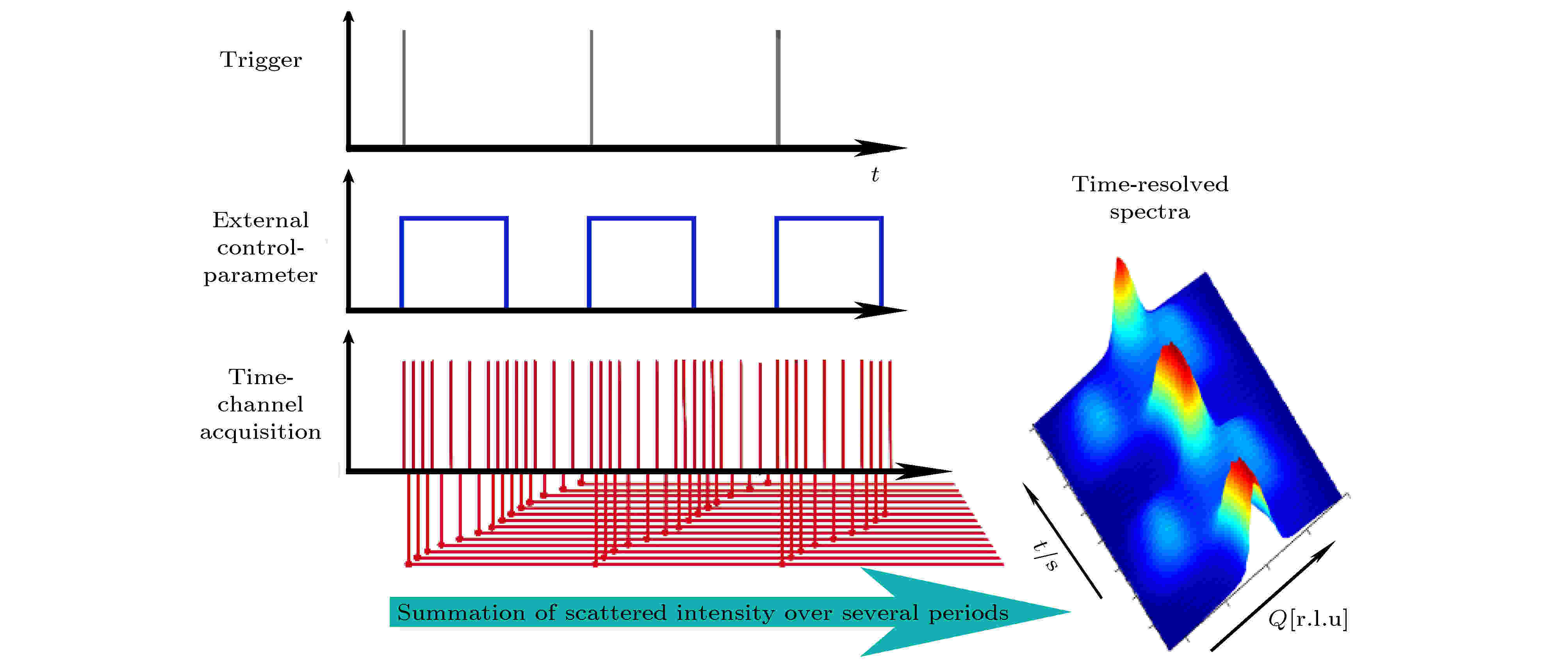
2020, 69 (12): 127711.
doi: 10.7498/aps.69.20200301
Abstract +
Ferroelectric/piezoelectric perovskites are an important class of functional material and have broad application prospects in commercial, industrial, military and other areas because of their high dielectric constants, high piezoelectric coefficients, and high electromechanical coupling coefficients. Their structures, applications, and physical mechanisms have been intensively studied in condensed matter physics and material science. The piezoelectric properties of ferroelectric materials mainly originate from the intrinsic field-induced lattice distortion and extrinsic domain inversion and domain wall motion. Therefore, the understanding of and the distinguishing between these mechanisms are important for ascertaining the origin of the high-piezoelectric properties and developing new functional materials. In this article, we review the research progress of technical means and methodology of analyzing the changes of crystal lattices and magnetic domains of materials under the action of an externally applied electric field through the high-energy synchrotron X-ray diffraction experiments. The techniques and analysis methods involved in the review cover the time-resolved X-ray diffraction, single/double-peak analysis, full-pattern refinement, center-of-mass calculation, and field-induced phase transformation analysis, which are used to study the intrinsic and extrinsic contributions to sample’s macroscopic properties. It is expected to provide the research methods, which fulfill the individual experimental requirements, and the technical support for the mechanism analysis of various piezoelectric materials through the introduction and review of various methods.

2020, 69 (12): 127712.
doi: 10.7498/aps.69.20200738
Abstract +
Rare earth doping is an important method to improve the properties of optoelectronic functional materials. Combining rare earth doping ferroelectric materials and rare earth photoluminescence can create new functional properties of ferroelectric materials. For example, choosing and using an appropriate rare earth element to be doped into a bismuth titanate ferroelectric material, the bismuth titanate will exhibit good photoluminescent properties as well as ferroelectric properties. Recently, photoluminescence properties originating from rare earth ions in oxide ferroelectric materials have attracted much attention for possible integrated photoluminescent ferroelectric device applications. In this paper, we briefly review the research status and progress of photoluminescence in rare earth photoluminescent ferroelectric materials, and we place the emphasis on our own research work in photoluminescent ferroelectric thin films such as (Bi,Eu)4Ti3O12, (Bi,Er)4Ti3O12, and codoped bismuth titanate thin films, and nanocomposite (Bi,Eu)4Ti3O12 ferroelectric thin films. Our results show that the rare earth doped bismuth titanate ferroelectric thin films exhibit good photoluminescent and ferroelectric properties due to unique compositions and layered perovskite structure, that the Eu3+ fluorescent structure probe can provide a new path for further studying the relationship between structure and property of Eu-doped ferroelectric thin films, that the rare earth photoluminescence can be used to examine the existence of morphotropic phase boundary in certain ferroelectric thin films such as Pr-doped x(K1/2Bi1/2)TiO3-(1-x)(Na1/2Bi1/2)TiO3 thin films, and nanocomposite materials of ZnO nanomaterials, and that Au nanoparticles, Ag nanoparticles with Eu-doped bismuth titanate exhibit obviously enhanced photoluminescent properties.
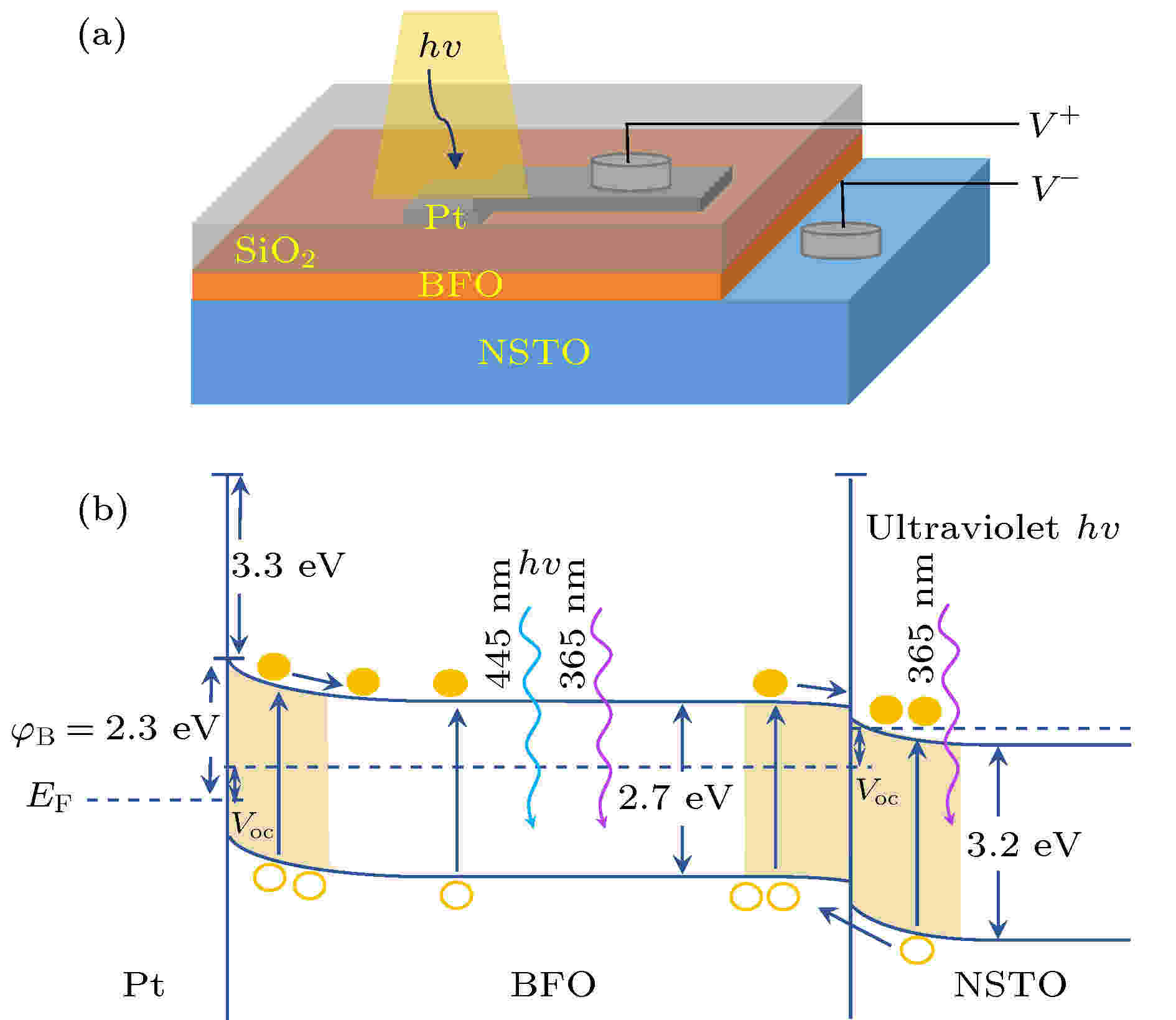
2020, 69 (12): 127301.
doi: 10.7498/aps.69.20200280
Abstract +
The photovoltaic effect of ferroelectric BiFeO3 (BFO)-based heterojunction has been one of hot subjects of theoretical and experimental studies due to its important application prospects, and the coexistence of varieties of photovoltaic effect mechanisms (bulk photovoltaic effect, domain wall effect, interfacial barrier effect, etc.) can bright rich and complicated physics nature. In order to investigate the important role that the interface plays in the photovoltaic effect, we prepare the Pt/BFO(60 nm)/Nb:SrTiO3 (NSTO) heterojunction with an asymmetric metal/ferroelectric/semiconductor structure, and systematically investigate the photovoltaic effect under laser irradiation with different wavelengths (365 nm and 445 nm). The heterojunction exhibits much stronger open-circuit voltage (Voc, ~0.55 V at 74 mW/cm2) and short-circuit current density (Jsc, ~ 208 μA/cm2 at 74 mW/cm2) for the laser irradiation with 365 nm wavelength than those for the laser irradiation with 445 nm wavelength, and the Voc and Jsc are both strengthened with the increase of light intensity. This is because the 365 nm light with the photon energy ~3.4 eV can stimulate photon-induced carriers in both BFO (band gap ~2.7 eV) and NSTO (band gap ~3.2 eV) at both the Pt/BFO interface and the BFO/NSTO interface, while the 445 nm light with the photon energy ~2.8 eV can only generate carriers in BFO. Thus the photovoltaic voltage is much bigger for the 365 nm light. Furthermore, the laser absorption process is much more efficient for the 365 nm light (79% absorbed in BFO and 21% absorbed in NSTO) than for the 445 nm light (21% absorbed in BFO). In addition, the temperature dependent Voc and Jsc are also investigated. It is found that for the 365 nm and 445 nm laser irradiation, the Voc increases with temperature decreasing, which is possibly due to the variations of the built-in potential, concentration of thermal charge carriers, and/or electron-phonon scatterings. The sharper variation of Voc above ~ 200 K may suggest the more significant role of thermal charge carriers at high temperatures. Interestingly, the temperature dependent Jsc behaves differently for the 365 nm and 445 nm light. Under the 365 nm laser irradiation, the Jsc remains almost unchanged below 170 K and increases sharply with temperature increasing above 170 K, which may be related to the dominant role of thermal excitation for the 365 nm light. While for the 445 nm light, the Jsc decreases with temperature increasing, which follows the variation trend of its Voc. What is more, the conduction mechanism of Pt/BFO/NSTO heterojunction under laser irradiation is also studied. It is found that the conduction for the 445 nm light can be nicely described by the space-charge-limited bulk conduction (SCLC) model and the photon-generated carriers may fill the traps and thus leading the transition voltage to decrease. While for the 365 nm light, the conduction is more complicated and cannot be described by the SCLC model. Our findings may be helpful in understanding the photovoltaic effect in transition-metal oxide based heterojunctions and designing photovoltaic devices.
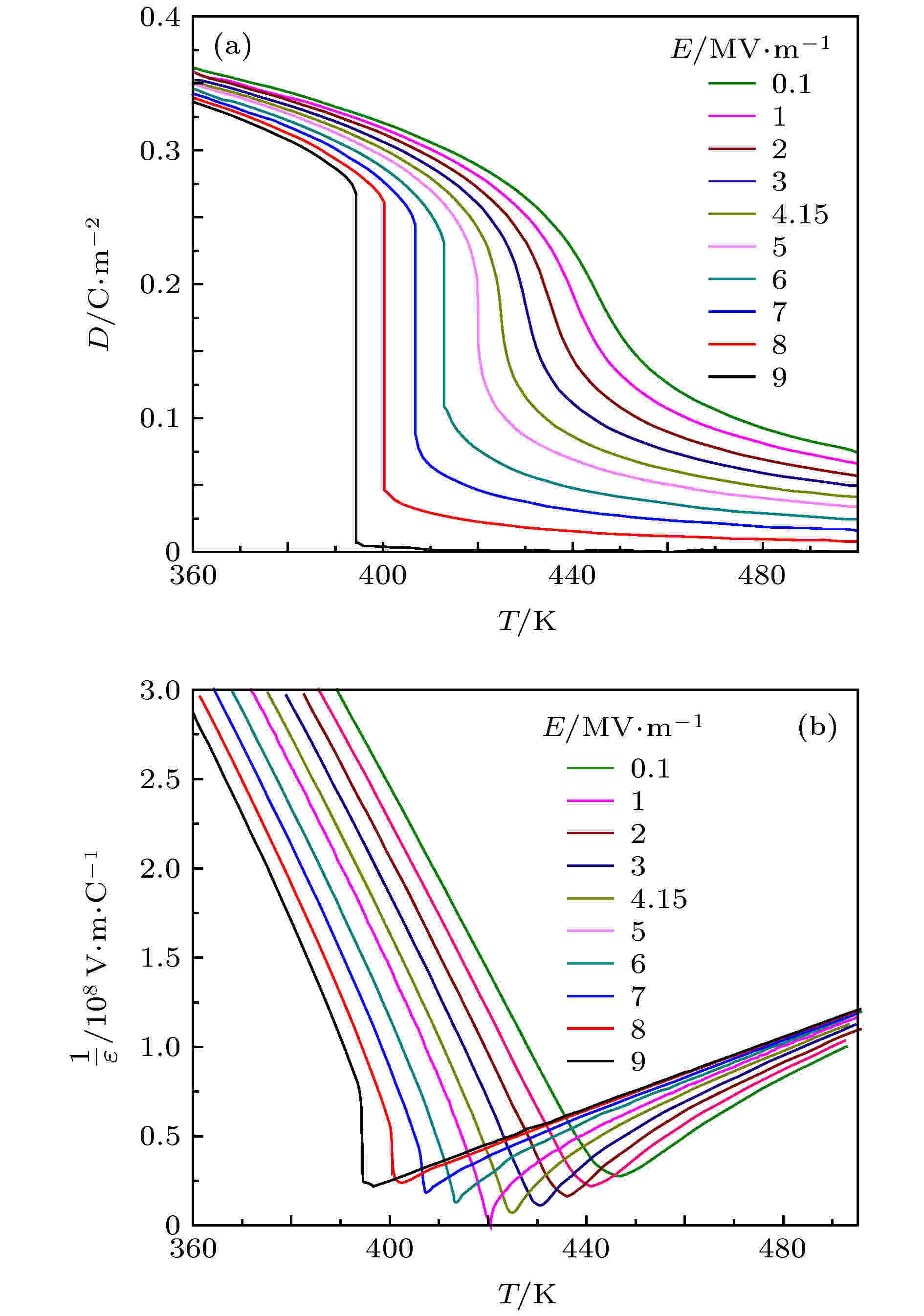
2020, 69 (12): 127701.
doi: 10.7498/aps.69.20200296
Abstract +
As the electric field can affect the polarization and dielectric constant, the phenomenological coefficient a0 is an implicit function of electric field. The phenomenological coefficient a0 is determined by the polarization and the reciprocal of permittivity, and a nonlinear function of electric field in the ferroelectric phase regime. In the paraelectric phase regime, however, a0 is merely subjected to the reciprocal of permittivity, and also a nonlinear function of electric field. In this paper, we investigate the electric field dependence of phenomenological coefficient in ferroelectric copolymers, terpolymers and Ba0.85Ca0.05Sr0.1TiO3 ceramics. It is indicated that the phenomenological coefficient increases with the increasing electric field, the maximum value is obtained to be about 2 times the original value. Moreover, the electrocaloric strength is used to measure the magnitude of electrocaloric effect of electrocaloric materials in an external electric field. It can be used to find out novel and efficient electrocaloric materials through studying the electrocaloric strength. Based on the thermodynamic theory, the analytical expression of electrocaloric strength is deduced. It is found that the phenomenological coefficient, phase transition, specific heat capacity, and permittivity versus temperature peak value at the phase transition temperature have a clear influence on the electrocaloric strength. The expression can be applied to 1st order, 2nd order phase transition materials and relaxor ferroelectrics.

2020, 69 (12): 127703.
doi: 10.7498/aps.69.20200213
Abstract +
Lead-free dielectric ceramics with high energy-storage density and efficiency are ideal energy materials for sustainable development of the enery resource. In this paper, (1–x)K0.5Na0.5NbO3–xBi(Mg0.5Ti0.5)O3 ((1–x)KNN-xBMT, x = 0.05, 0.10, 0.15, 0.20) lead-free relaxor ferroelectric ceramics are prepared by the traditional solid-state method. The effects of BMT on the phase structure, microstructure, dielectric properties and energy storage behavior of KNN based ceramics are studied. With the increase of BMT content, the crystal structures of (1–x)KNN-xBMT ceramics gradually change from orthorhombic to pseudo-cubic phase, and transform into cubic phase finally. The addition of BMT can suppress grain growth of the ceramics, resulting in the average grain size decreasing from 850 to 195 nm when x increases from 0.05 to 0.20. Dielectric properties exhibit that the Curie temperature decreases with BMT content increasing, and dielectric peak at Curie temperature is broadened due to the addition of BMT. In addition, ferroelectric properties demonstrate that the addition of BMT reduces the remnant polarization (Pr) and coercive field (Ec) of the ceramics. The results indicate that (1–x)KNN-xBMT ceramics transform from ferroelectric to relaxor ferroelectric phase. Based on the calculation of hysteresis loop, the best energy storage performance is obtained at x = 0.15, of which the recoverable energy storage density (Wrec) and the energy storage efficiency (η) are 2.25 J·cm–3 and 84% at its dielectric breakdown strength of 275 kV·cm–1. Meanwhile, the ceramic with x = 0.15 exhibits good stability in a frequency range of 1–50 Hz, with an energy density variation of less than 5%, and temperature stability in a range of 25–125 ℃ with change of less than 8%. Moreover, based on direct measurement, the energy storage density (Wdis) of the ceramic with x = 0.15 is 1.54 J·cm–3, and the discharge time is only 88 ns. The research shows that (1–x)KNN-xBMT ceramics have a wide application prospect in the field of environmentally friendly capacitors with high energy storage density.
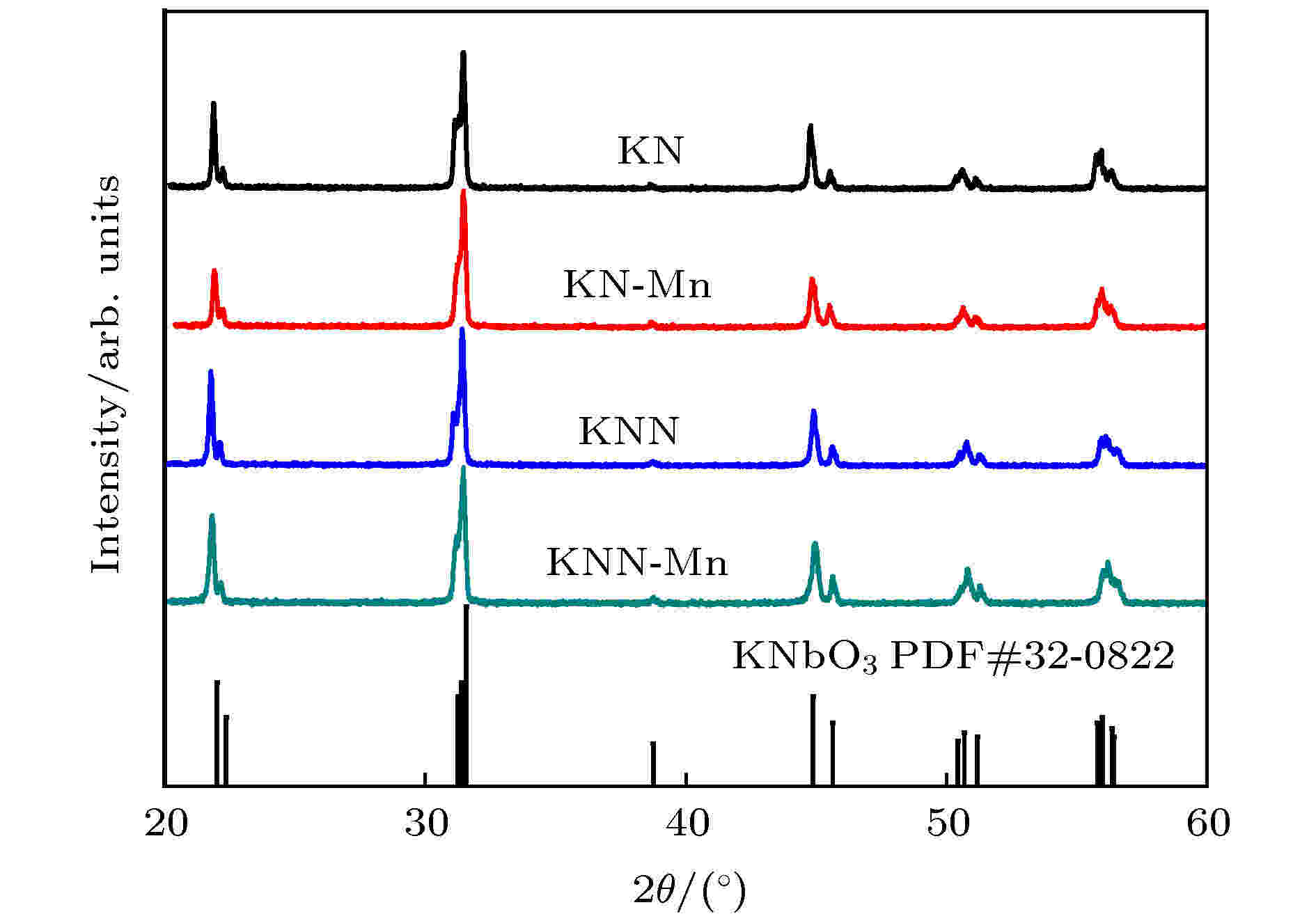
COVER ARTICLE
2020, 69 (12): 127705.
doi: 10.7498/aps.69.20200277
Abstract +
Potassium sodium niobate ((K0.5Na0.5)NbO3)-based lead-free piezoelectric ceramics are excellent ferroelectric materials and have been demonstrated to have many practical applications. Recent studies have revealed that chemical doping plays a crucial role in optimizing the electromechanical coupling properties of (K0.5Na0.5)NbO3-based piezoelectric ceramics. In this paper, MnO2 is doped into potassium niobate (KNbO3) and (K0.5Na0.5)NbO3 piezoelectric ceramics prepared by the conventional solid-state reaction method. The influences of doped Mn cation on KNbO3 and (K0.5Na0.5)NbO3 piezoelectric ceramics including microstructure and macroscopic electrical properties are systematically investigated. The doping effects of Mn cation on the KNbO3 and (K0.5Na0.5)NbO3 piezoelectric ceramics are significantly different from each other. For the Mn-doped KNbO3 piezoelectric ceramics, the sizes of ferroelectric domains are reduced. Meanwhile, the diffused orthorhombic-tetragonal phase transition is observed, which is accompanied by reducing dielectric loss and Curie temperature, and broadening vibration peaks in Raman spectrum. It is known that the oxygen vacancy can be formed to compensate for the charges created by the acceptor doping of Mn into the B site of perovskite, and thus forming a defect dipole with the acceptor center. From the ferroelectric measurement, a double hysteresis loop (P-E curve) and a recoverable electric-field-induced strain due to the formation of defect dipole are observed. On the contrary, for the Mn-doped (K0.5Na0.5)NbO3 piezoelectric ceramics, the sizes of ferroelectric domains are not reduced. Meanwhile, the Curie temperature and vibration peaks in Raman spectrum are not changed. A rectangular hysteresis loop (P-E curve) and an unrecoverable electric-field-induced strain are observed in the ferroelectric measurement. The difference between these systems might originate from the greater ionic disorder and lattice distortion in (K0.5Na0.5)NbO3 piezoelectric ceramics. The difference in ionic radius between Na+ and K+ can affect the migration and distribution of oxygen vacancies, which makes it difficult to form stable defect dipoles in the Mn-doped (K0.5Na0.5)NbO3 piezoelectric ceramics. The results will serve as an important reference for preparing high-performance (K0.5Na0.5)NbO3-based piezoelectric ceramics via chemical doping.

2020, 69 (12): 127709.
doi: 10.7498/aps.69.20200309
Abstract +
Ferroelectric films, are an important class of photoelectric functional material, which possess the following characteristics: the breaking of their symmetry can lead to self-polarization and this polarization state can be regulated by external stimuli. The photovoltaic properties of ferroelectric films have been extensively investigated due to their potential applications in the field of photodetection, energy conversion harvesting and nonvolatile storage. In view of the small photocurrent density and the degradation of photovoltaic property caused by the depolarization effect in ferroelectric films, it is necessary to explore an approach to improving the self-polarization phenomenon and regulating the conduction mechanism to further optimize their photovoltaic properties. Here in this work, BiFeO3 (BFO) films dispersed with Au nanoparticles are deposited on FTO glass substrates by the sol-gel method to obtain the Au-BFO nanocomposite films. Moreover, the relationships between Au content (0 mol%, 0.25 mol%, 0.5 mol%, 1 mol% and 3 mol%) and microstructure, electrical and photovoltaic properties of Au-BFO nanocomposite films are investigated to determine the optimal Au content. Piezoresponse force microscopy studies show that the Au-BFO nanocomposite film with 0.5 mol% Au has the strong self-polarization phenomenon. With the increase of Au content, the conduction mechanism of the Au-BFO nanocomposite films is described by the space-charge limited current theory but not the Schottky emission model any more. The photovoltaic properties of the Au-BFO nanocomposite films first increase and then decrease. When Au content is 0.5 mol%, the Au-BFO nanocomposite film has the best photovoltaic property. The open-circuit voltage and short-circuit photocurrent density of the Au-BFO nanocomposite film with 0.5 mol% Au increase nearly 3 and 5 times counterparts of the BFO film, respectively. The photovoltaic effects of Au-BFO nanocomposite films are improved mainly by regulating the self-polarization phenomenon and conduction mechanism. This study demonstrates the merits of BFO films dispersed with Au nanoparticles, specifically, the photovoltaic properties of Au-BFO nanocomposite films are further optimized. In this work, we propose a simple and effective method to regulate the electrical and photovoltaic properties of ferroelectric films, which provides a new perspective for further understanding the photovoltaic effects of ferroelectric films.
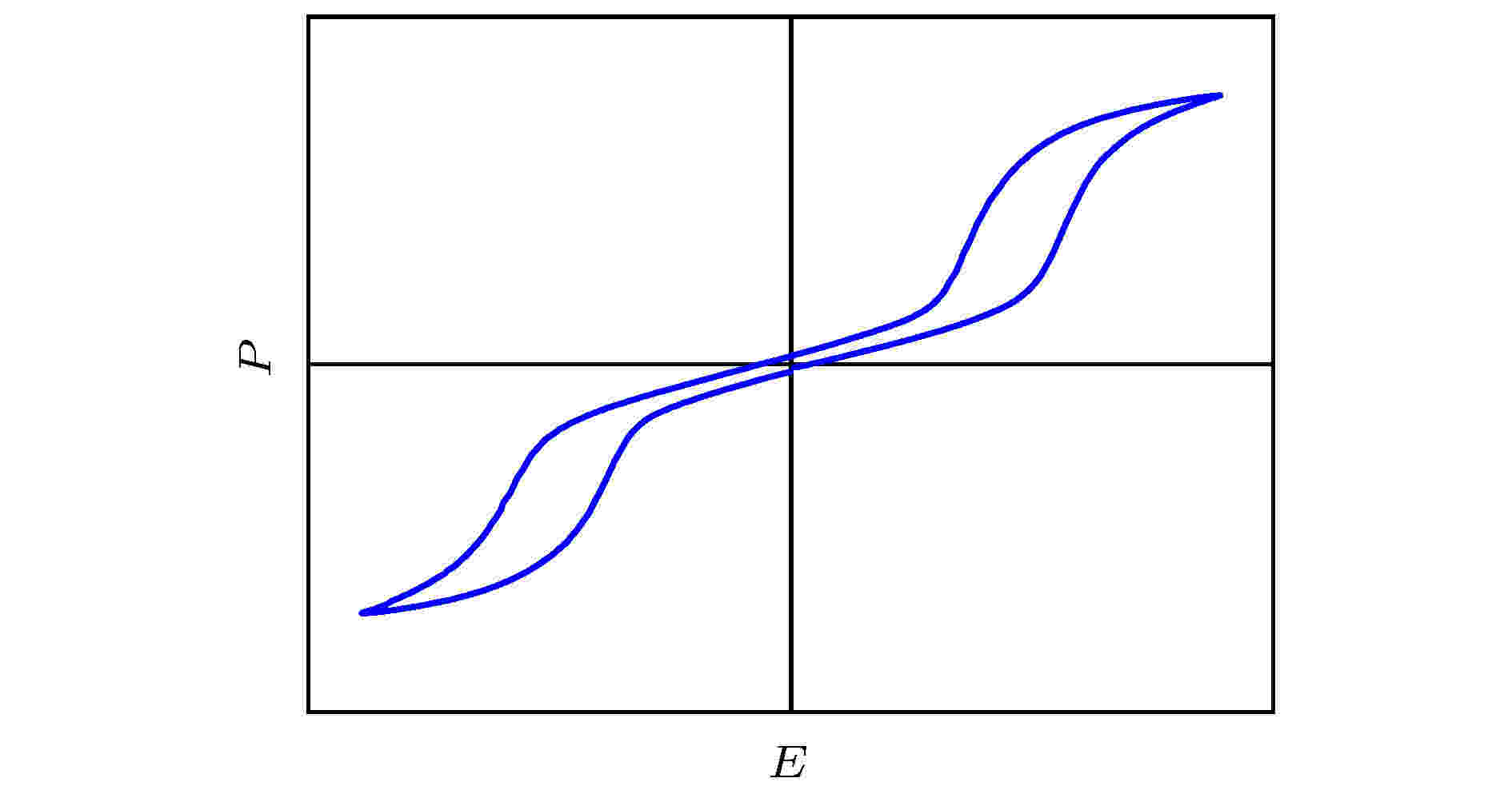
2020, 69 (12): 127710.
doi: 10.7498/aps.69.20200209
Abstract +
In real applications, antiferroelectric (AFE) ceramics are usually subjected to a pulse electric field with fast rising or falling speed. In the measurement of hysteresis loop at low frequency, the applied electric field has a low changing rate. Thus, the obtained results cannot reveal the polarization nor phase transition of AFE ceramics in real applications. In the present work, a platform to measure the pulse hysteresis loop is developed and the polarization and phase transition of Pb0.94La0.04[(Zr0.52Sn0.48)0.84Ti0.16]O3 (PLZST) AFE ceramics under pulse electric field on a μs scale are investigated. The obtained results indicate that the phase transition can be induced by pulse electric field. However, the maximum polarization decreases, the forward transition field increases and the backward one decreases, resulting in the variation of energy storage performance. Thus, the hysteresis loop at low frequency cannot reveal the performance of AFE ceramics under the action of a pulse electric field. The pulse hysteresis loop is of great significance in real applications.

2020, 69 (12): 127801.
doi: 10.7498/aps.69.20200310
Abstract +
Ferroelectric domain structures and ferroelectric properties in the hetero-epitaxially constrained ferroelectric thin films can be manipulated by substrate misfit strain. In this work, three kinds of phase structures of PbZr(1–x)TixO3 thin films, including tetragonal, tetragonal- rhombohedral-mixed and rhombohedral phases, are investigated. Firstly, the ferroelectric domain structures at different substrate misfit biaxial strains are obtained by the phase-field simulation. Then we calculate the polarization-electric field hysteresis loops at different misfit strains, and obtain the coercive field, saturation polarization, and remnant polarization. In the tetragonal PbZr(1–x)TixO3 (x = 0.8) thin film, compressive strain contributes to the formation of out-of-plane c1/c2 domain, and tensile strain favors in-plane a1/a2 domain formation. With the increase of compressive strain, the tetragonal phase and the rhombohedral phase coexist in PbZr(1–x)TixO3 (x = 0.48) film near the morphotropic phase boundary, while the tensile strain reduces the rhombohedral domain size. In the rhombohedral PbZr(1–x)TixO3 (x = 0.2) film, the rhombohedral domains are steady states under compressive strain and tensile strain. As the misfit strain changes from –1.0% to 1.0%, the value of the coercive field, saturation polarization and remnant polarization decrease. Among them, for tetragonal-rhombohedral mixed phase, the reductions of saturation field and remnant polarization are larger than for tetragonal phase and rhombohedral phase. The coercive field of mixed phase decreases rapidly under the compressive strain, but deceases slowly under the tensile strain. It is worth noting that the remnant polarization decreases faster than the saturation polarization in three components of ferroelectric thin film. Due to the electromechanical coupling, when x = 0.48 at the morphotropic phase boundary it is shown that the remnant polarization reduction is faster than those of the other two types of ferroelectric thin films, and the small coercive field is obtained in the case of large tensile strain. Therefore, tensile strain can effectively improve the energy storage efficiency in ferroelectric thin films, and the efficiency of x = 0.48 thin film increases significantly compared with that of x = 0.8 or 0.2 thin film. Both the ratio of rhombohedral/tetragonal phase and the domain size will play a significant role in ferroelectric performance. Therefore, our results contribute to the understanding of the electromechanical coupling mechanism of PbZr(1–x)TixO3, and provide guidance for the experimental design of ferroelectric functional thin film materials.
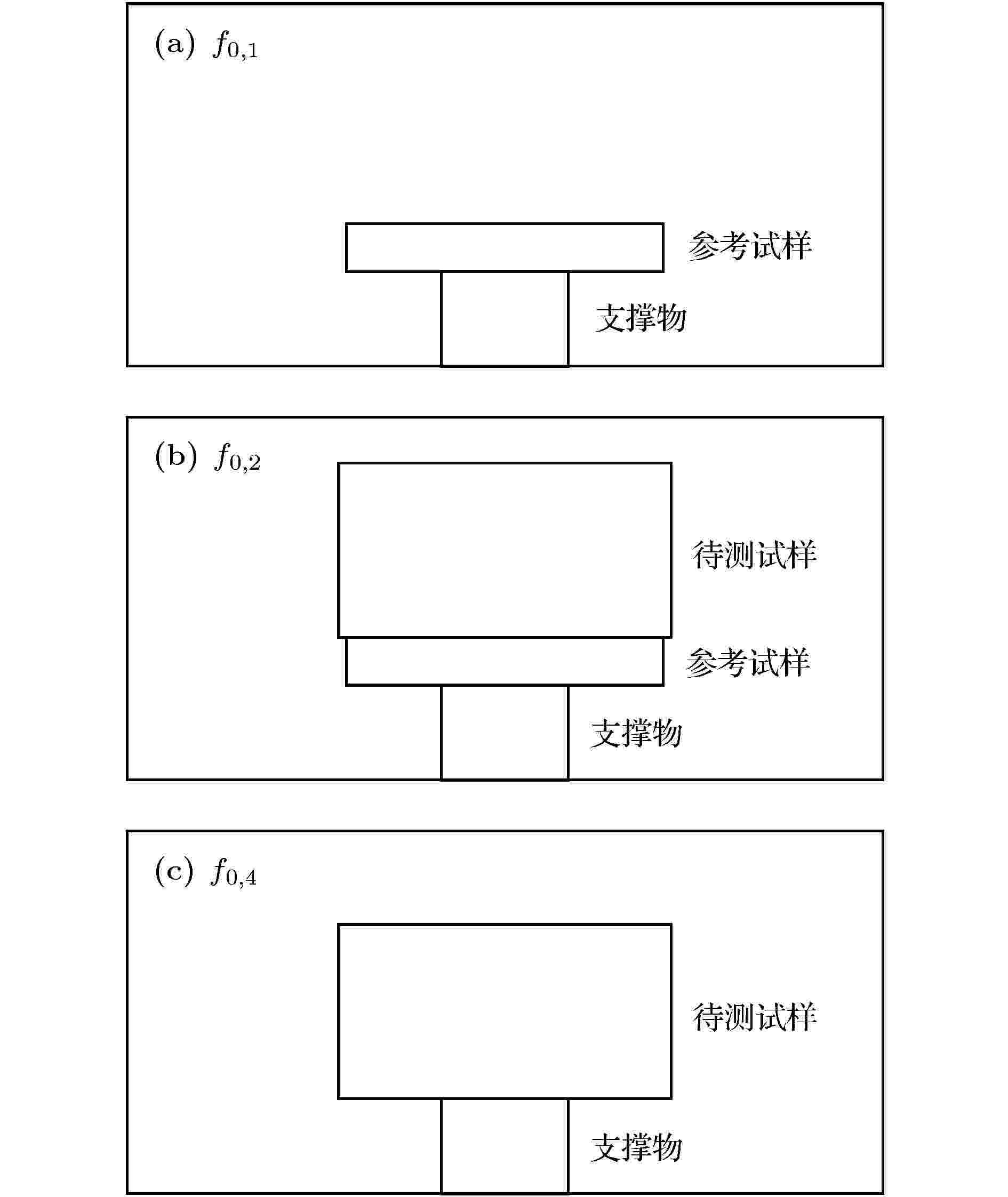
2020, 69 (12): 128401.
doi: 10.7498/aps.69.20200275
Abstract +
The metal resonant cavity method working with TE01δ mode is a universal method for evaluating the microwave dielectric properties of low-loss materials. All the microwave dielectric resonators are multi-mode resonators, so the correct identification of TE01δ mode is the basis for the microwave dielectric measurements. The TE01δ mode can be identified by predicting the resonant frequency and its variation with resonator size, expelling the spurious modes according to the exciting conditions, etc., while these methods are relatively complex and sometimes unreliable. In the present work, a simple method for accurately identifying the TE01δ mode is developed. A low-loss reference sample with known dielectric properties is introduced and placed in the cavity for the first step, and the to-be-measured sample is placed on the reference sample for the second step. The rough permittivity of the to-be-measured sample can be calculated from the TE01δ-mode resonant frequencies in the two steps through the finite element analysis, and is used to predict the resonant frequency for TE01δ mode when only the to-be-measured sample is placed in the cavity. The difference between the predicted and measured TE01δ-mode resonant frequencies for the to-be-measured sample is less than 1%, so that the TE01δ mode can be easily distinguished from the spurious modes and accurately identified.
GENERAL
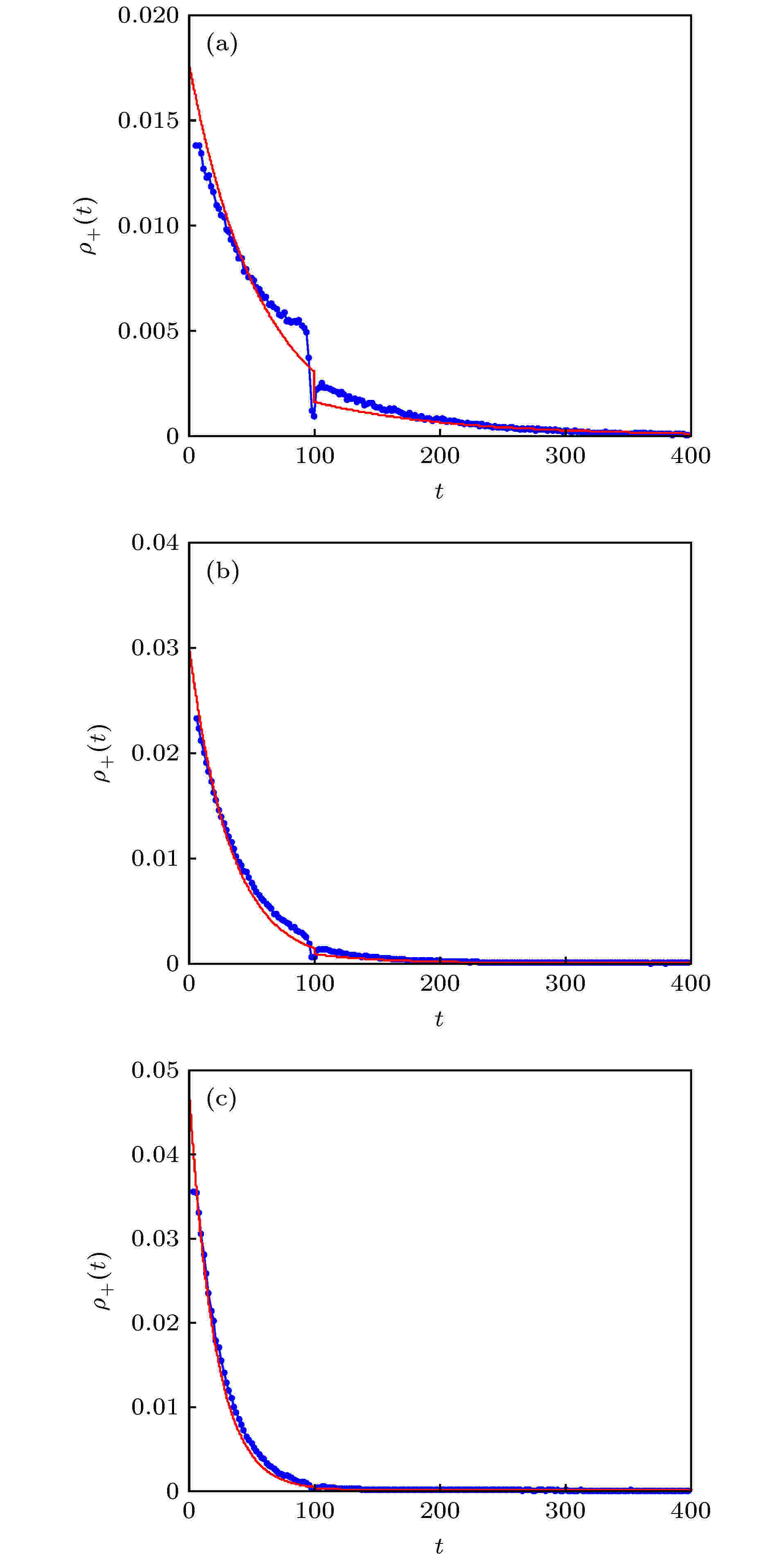
2020, 69 (12): 120501.
doi: 10.7498/aps.69.20201752
Abstract +
Residence-times distribution function (RTDF), as a distribution function of times between two consecutive switches in a bistable system, is extensively used to characterize the phenomenon of stochastic resonance (SR). However, most of the studies focus on the symmetric bistable systems. As a matter of fact, the majority of asymmetric systems encountered in nature are more universal and practical. Additionally, due to the combination of diverse propagations or transduction mechanisms, noise recycling, constituted by the superposition of a master noise with a secondary component delayed by a time shift τ, can be generated while a noise is injected into a system and transmitted across the system. Therefore, an asymmetric system subjected to noise recycling is no longer non-Markovian. As a result, it is essential to take the special correlation of noise recycling into account when studying the transition dynamics of particles, which makes it difficult to obtain the analytical formula of RTDF. To solve the above problem, a theoretical method to calculate the RTDF of an asymmetric bistable system driven by noise recycling is put forward in this paper. By using the two-state model with piecewise escape rate, the piecewise escape rate function can be established, based on which the RTDF is derived theoretically with a piecewise formula. It is emphatically demonstrated theoretically and numerically that the RTDF exhibits a feedback-induced structure due to the asymmetry of system. Meanwhile, the effects of relative strength and recycling lag on the structure of RTDF are investigated theoretically and numerically. The results are shown as follows: when the asymmetry satisfies γ > 0 and taking γ as the appropriate values, the RTDF decays exponentially and exhibits a sharp dip at t = τ. Nevertheless, on the contrary, under the condition for γ < 0, the dip at t = τ of RTDF almost disappears and the rate of decay of RTDF turns to increase. When the relative strength and recycling lag take the appropriate values separately, the RTDF displays piecewise exponential decay and declines sharply at t = τ. It is worth noting that the interval between discontinuities becomes smaller, or even disappears with the relative strength and recycling lag increasing separately. Further, the value of RTDF at t = τ presents a maximum value with the noise intensity and the relative strength varying, which illustrates that the noise recycling procedure can play a crucial role in inducing the phenomenon of SR in the asymmetric bistable system.
ATOMIC AND MOLECULAR PHYSICS
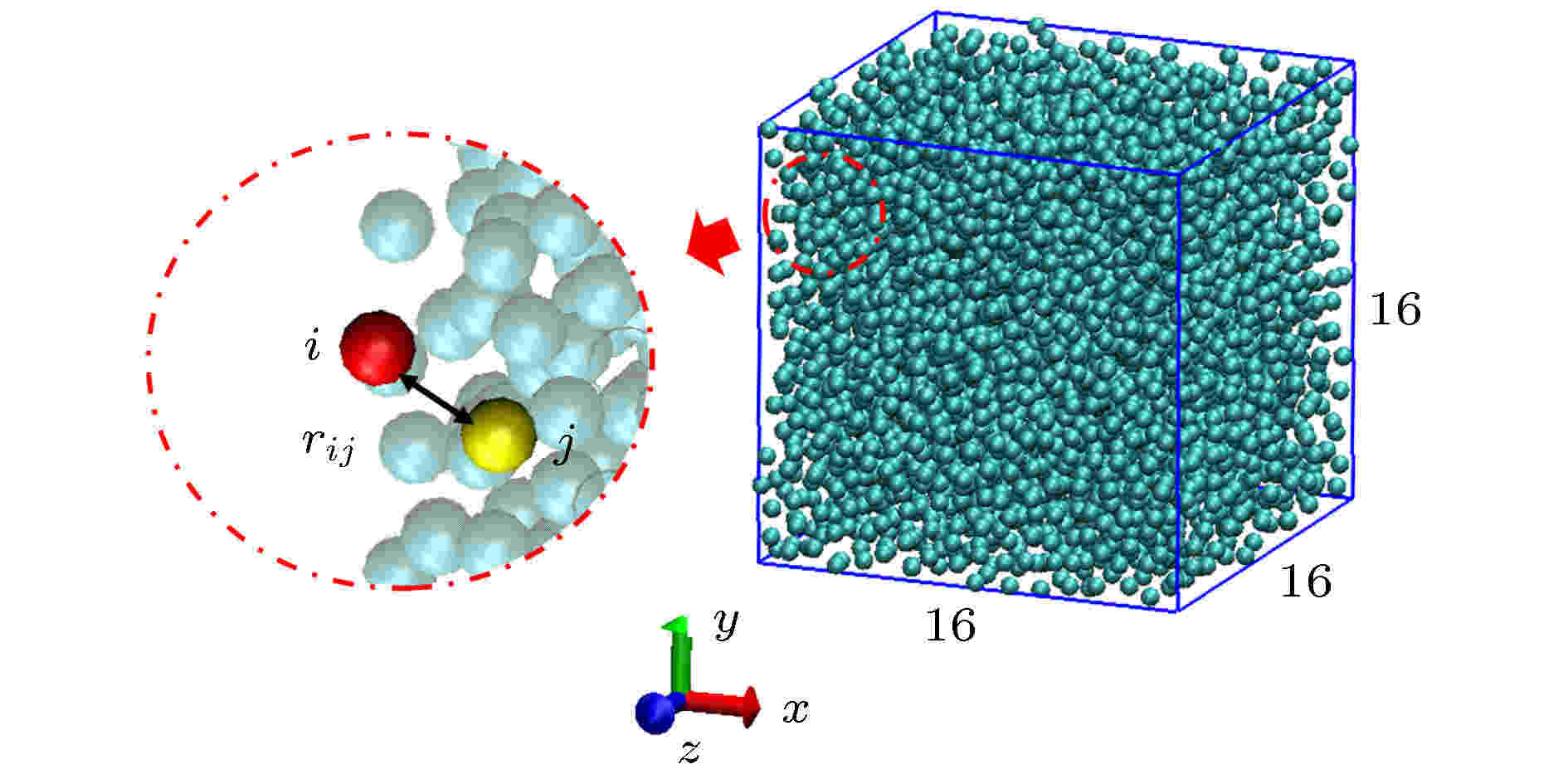
2020, 69 (12): 123101.
doi: 10.7498/aps.69.20200138
Abstract +
Viscoelastic relaxation time is an important concept to characterize the viscoelastic response of materials, which is directly related to the interactions among the microscopic atoms of materials. Few studies have focused on the methods of characterizing viscoelastic relaxation time. To investigate how to represent viscoelastic relaxation time effectively, the viscoelastic relaxation times of the monoatomic Lennard-Jones system on 22 conditions in a range of $ T^{ *} $ = 0.85–5, ρ* = 0.85–1, ε = 0.97–1, and σ = 0.8–1.3 are discussed from a microscopic perspective by the equilibrium molecular dynamics methods. Static viscoelasticity (viscosity η*, high-frequency shear modulus $ G_{\infty}^* $ ) is calculated by the Green-Kubo formula, and the Fourier transform is applied to the calculation of dynamic viscoelasticity (storage modulus $ G'^* $ and loss modulus $ G''^* $ ). On this basis, the viscoelastic characteristic relaxation time ($ \tau _{{\rm{MD}}}^*$ ), Maxwell relaxation time ($ \tau _{{\rm{Maxwell}}}^*$ ) and the lifetime of the state of local atomic connectivity ($ \tau _{{\rm{LC}}}^*$ ) are calculated. The viscoelastic characteristic relaxation time $ \tau _{{\rm{MD}}}^*$ , defined when the two responses crossover, is the key measure of the period of such a stimulus when the storage modulus (elasticity) equals the loss modulus (viscosity). Maxwell relaxation time $ \tau _{{\rm{Maxwell}}}^* = {\eta ^*}/G_\infty ^*$ , where η* is the static viscosity under infinitely low stimulus frequency (i.e., zero shear rate), $ G_{\infty}^* $ is the instantaneous shear modulus under infinitely high stimulus frequency, and $ \tau _{{\rm{LC}}}^*$ is the time it takes for an atom to lose or gain one nearest neighbor. The result is observed that $ \tau _{{\rm{LC}}}^*$ is closer to $ \tau _{{\rm{MD}}}^*$ than $ \tau _{{\rm{Maxwell}}}^*$ . But the calculation of $ \tau _{{\rm{LC}}}^*$ needs to take into count the trajectories of all atoms in a certain time range, which takes a lot of time and computing resources. Finally, in order to characterize viscoelastic relaxation time more easily, Kramers’ rate theory is used to describe the dissociation and association of atoms, according to the radial distribution functions. And a method of predicting the viscoelasticity of the monoatomic Lennard-Jones system is proposed and established. The comparison of all the viscoelastic relaxation times obtained above shows that $ \tau _{{\rm{Maxwell}}}^*$ is quite different from $ \tau _{{\rm{MD}}}^*$ at low temperature in the monoatomic Lennard-Jones system. Compared with $ \tau _{{\rm{Maxwell}}}^*$ , $ \tau _{{\rm{LC}}}^*$ is close to $ \tau _{{\rm{MD}}}^*$ . But the calculation of $ \tau _{{\rm{LC}}}^*$ requires a lot of time and computing resources. Most importantly, the relaxation time calculated by our proposed method is closer to $ \tau _{{\rm{MD}}}^*$ . The method of predicting the viscoelastic relaxation time of the monoatomic Lennard-Jones system is accurate and reliable, which provides a new idea for studying the viscoelastic relaxation time of materials.
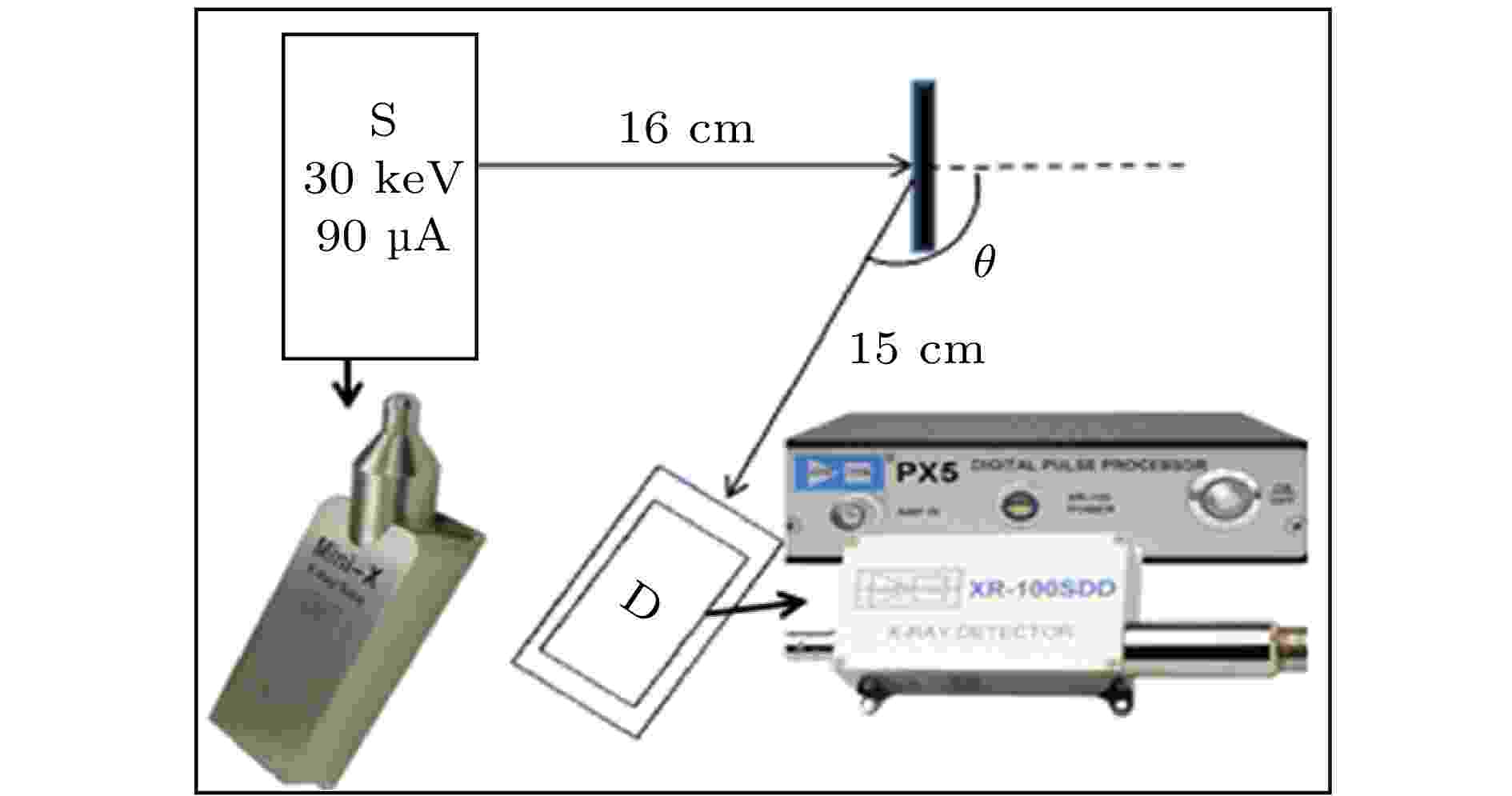
2020, 69 (12): 123201.
doi: 10.7498/aps.69.20191977
Abstract +
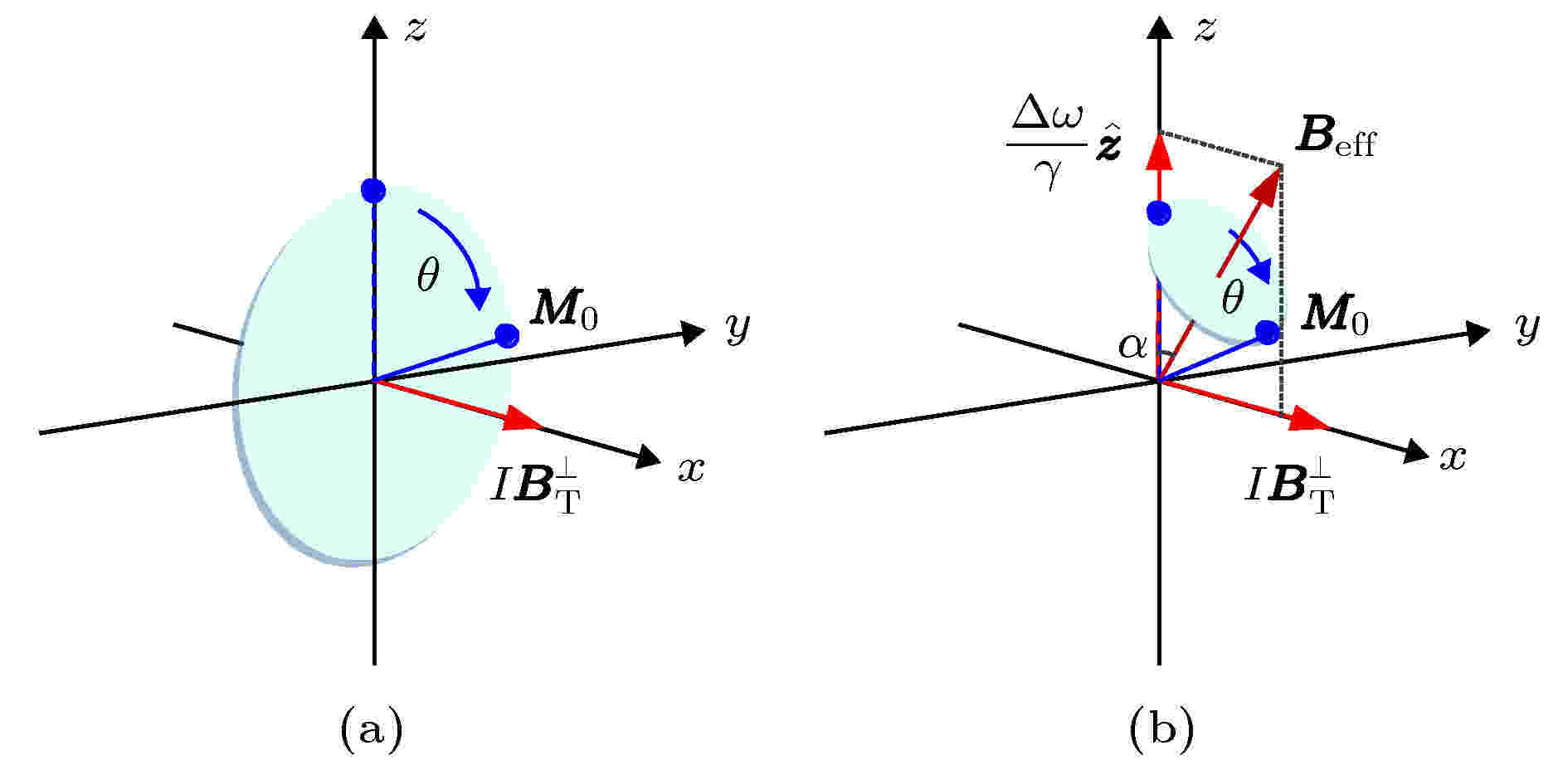
2020, 69 (12): 123301.
doi: 10.7498/aps.69.20200015
Abstract +
Magnetic resonance sounding (MRS) technology used to detect groundwater directly and quantificationally, which owns the advantages of rich information and low cost. In these years, it has shown significant potential applications in hydrological detections. Considering the traditional measurements with the geomagnetic field, the nano-valt MRS signals are easy to suppress to environmental noise. As one of the MRS signal enhancement methods, the adiabatic pulse was quite popular recently. It is transmitted with variable frequency and amplitude pulse satisfying the adiabatic condition, which can enhance the signal amplitude and signal-to-noise ratio several times. However, there are only a few reports about this method, especially its geophysical modeling. Thus, we introduce the calculating progress of transverse magnetization and kernel function for this method. By employing the interpolation, the computation cost of forward modeling is obviously reduced. Moreover, several different settings of adiabatic transmitting factors are also proceeded to obtain certain results. In conclusion, a pulse moment with 80 ms transmitting duration and 30 quality factor produces a maximum signal amplitude that is enhanced 16.56 times for deep areas. The research in this paper could provide powerful support for MRS method used in noisy environments.
ELECTROMAGNETISM, OPTICS, ACOUSTICS, HEAT TRANSFER, CLASSICAL MECHANICS, AND FLUID DYNAMICS

2020, 69 (12): 124201.
doi: 10.7498/aps.69.20200324
Abstract +
An efficient Nd:YVO4 crystal self-Raman laser combined with second-order nonlinear frequency conversion is demonstrated to achieve an switchable output of three wavelengths in the yellow-green band. In order to improve the thermal effect and increase the length of Raman medium, a three-stage diffusion-bonded YVO4/Nd:YVO4/YVO4 crystal is designed for high power and efficient self-Raman laser operation. Selective frequency mixing mechanisms between the fundamental wave and the first Stokes wave using the LiB3O5 (LBO) and BaB2O4 (BBO) crystals are comparatively studied by temperature tuning and angle tuning, respectively. Considering the frequency mixing conversion efficiency and a relatively fast wavelength switching, the BBO crystal with critical phase matching is selected as the second order nonlinear optical crystal for frequency conversion. It only needs to fine-tune the phase match angle of BBO crystal within 1.4°, and thus successfully realizing all second harmonic and sum frequency generation between the fundamental wave and the first Stokes wave. Therefore the efficient-switchable output of the three wavelengths of 532 nm green light, 559 nm lime light and 588 nm yellow light is obtained. Under the incident pump power of 19.5 W and the pulse repetition rate of 60 kHz, maximum average output power of 4.37 W at 532 nm, 2.03 W at 559 nm, 3.43 W at 588 nm are achieved. The conversion efficiency values of the corresponding pump light to visible light are 22.4%, 10.4% and 17.6%, respectively. The corresponding pulse widths are 36 ns, 12.2 ns and 12.7 ns, respectively. The results show that the selective frequency mixing of self-Raman operation is an efficient approach to achieving the wavelength-switchable emission in visible waveband. This wavelength-switchable laser source has important applications in the areas of laser therapy, visual display, spectral imaging and biological medicine.
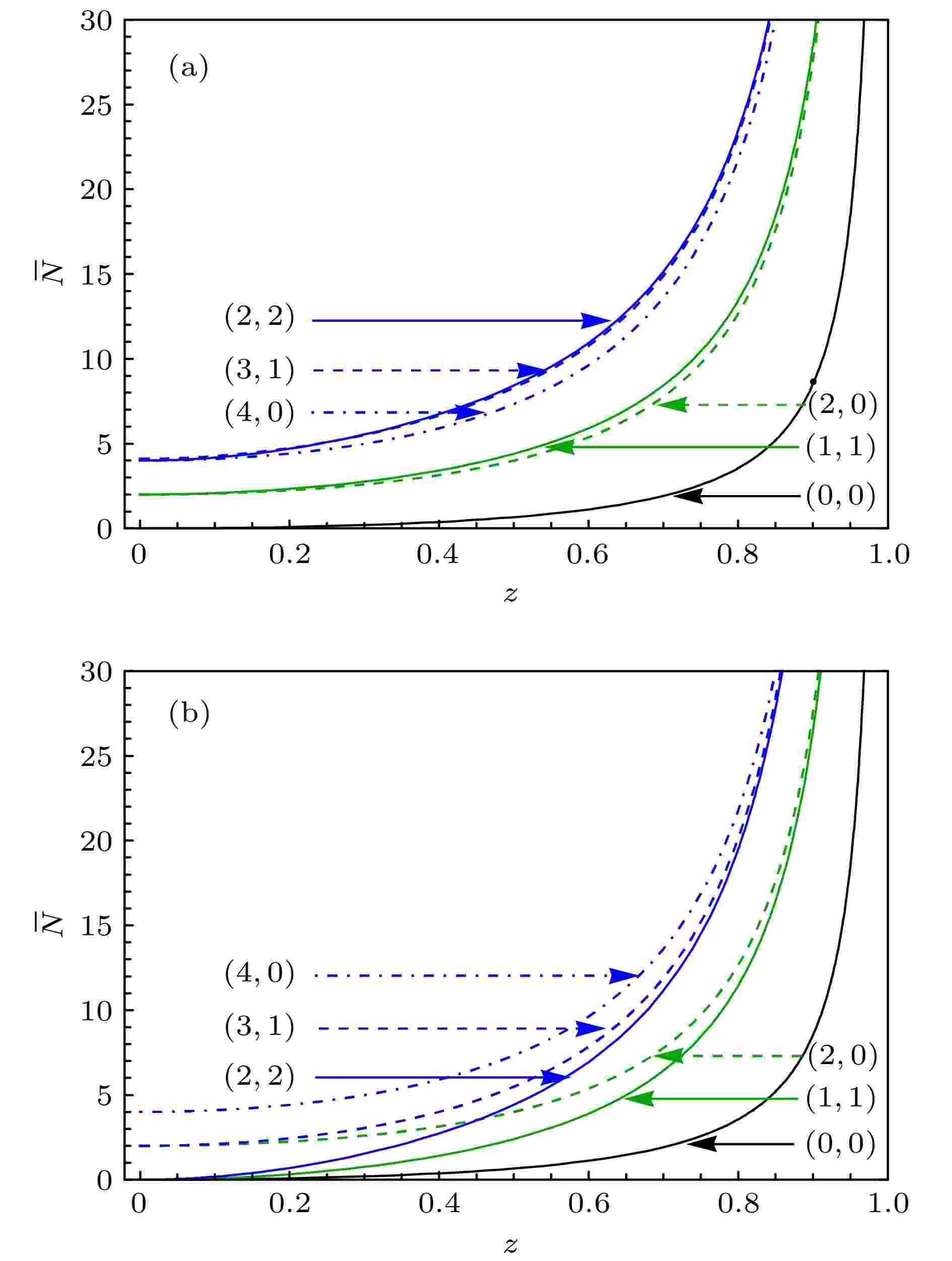
EDITOR'S SUGGESTION
2020, 69 (12): 124202.
doi: 10.7498/aps.69.20200179
Abstract +
Quantum metrology is to estimate accurately the value of an unknown parameter with the assistance of the quantum effects, in order to break through the standard quantum limit, even reach the Heisenberg limit. In this work, we study the performance of a general photon-added two-mode squeezed vacuum state that is taken as a detection state of a Mach-Zehnder interferometer. Based on quantum Fisher information, within the constraint on the total mean photon number, symmetric and asymmetric photon addition cannot improve the ultimate phase sensitivity. However, for a given initial squeezing parameter, on this occasion, the symmetric and asymmetric photon addition can improve the ultimate phase sensitivity. Compared with the asymmetric photon-added two-mode squeezed vacuum state, the symmetric one can well improve the ultimate phase sensitivity. This may be because it is always better to implement the symmetric photon addition rather than the asymmetric one in order to increase the mean photon number of the resulting state. On the other hand, via parity detection, the symmetric and asymmetric photon-added two-mode squeezed vacuum state can indeed improve the phase sensitivity of a Mach-Zehnder interferometer for a given initial squeezing parameter. Based on the parity detection, within a constraint on the mean photon number, although the two-mode squeezed vacuum state can give the better phase sensitivity at the optimal phase shift (φ = 0), the phase sensitivity offered by the symmetric and asymmetric photon-added two-mode squeezed vacuum states are both more stable around φ = 0 than by the two-mode squeezed vacuum state. In addition, we show that for the symmetric photon-added two-mode squeezed vacuum state, parity detection is an optimal detection only when the optimal phase shift approaches to zero. When the phase shift slightly deviates from zero, the parity detection is not an optimal detection scheme. Finally, for all values of the phase shift, our results also clearly show that the parity detection is not an optimal detection scheme for the asymmetric photon-added two-mode squeezed vacuum state serving as an interferometer state.

2020, 69 (12): 124203.
doi: 10.7498/aps.69.20200107
Abstract +
Continuous variable (CV) quantum squeezed state and entangled state are important quantum resources, which have been widely used in quantum communication, quantum metrology and quantum computation. In recent years, people have paid much attention to the multi-mode optical parametric amplifier (OPO) process because the multi-mode non-classical light field is able to construct the multiplexing quantum information system for improving the working efficiency and channel capacity. As a special multi-mode optical field, optical frequency comb has been used in optical frequency measurement, atomic spectroscopy and frequency-division multiplex-based communication. Especially, there are a number of notable researches where quantum frequency combs are used, which exhibit multimode-entangled photon states. The quantum frequency combs provide a promising platform for quantum information technology based on time-bin-encoded qubits. In this paper, the entanglement characteristics of frequency comb in type II nondegenerate optical parametric amplifier (NOPA) below threshold are investigated experimentally. The bipartite entanglement with frequency comb structure between idle light ($\hat a_{{\rm{i}}, + n\varOmega }^{{\rm{out}}}$ ) and signal light($\hat a_{{\rm{s}}, + n\varOmega }^{{\rm{out}}}$ ) is generated by the NOPA whose free spectral range (Ω) is 1.99 GHz operated in the de-amplification state and then analyzed by dual balanced homodyne detection system (BHD) with different values of frequency $\omega \pm n\varOmega $ (n = 0, 1, 2). The local light of BHD with frequency $\omega \pm n\varOmega $ is generated by the fiber intensity modulator and tailored by the mode cleaner. Here, we measure the correlation noise of side and frequency combs normalized to the shot noise limit relating to the phase of local oscillator beam, and we show the correlation noise of $\hat a_{\rm{i}}^{{\rm{out}}}$ and $\hat a_{\rm{s}}^{{\rm{out}}}$ , the correlation noise of $\hat a_{{\rm{i}}, + \varOmega }^{{\rm{out}}}$ and $\hat a_{{\rm{s}}, - \varOmega }^{{\rm{out}}}$ , the correlation noise of $\hat a_{{\rm{i}}, - \varOmega }^{{\rm{out}}}$ and $\hat a_{{\rm{s}}, + \varOmega }^{{\rm{out}}}$ , the correlation noise of $\hat a_{{\rm{i}}, + 2\varOmega }^{{\rm{out}}}$ and $\hat a_{{\rm{s}}, - 2\varOmega }^{{\rm{out}}}$ and the correlation noise of $\hat a_{{\rm{i}}, - 2\varOmega }^{{\rm{out}}}$ and $\hat a_{{\rm{s}}, + 2\varOmega }^{{\rm{out}}}$ . The experimental results show that the five pairs of entangled states with 4.5 dB entanglement are simultaneously produced by a type II OPO. Next, we can redesign NOPA to reduce its free spectral range and intracavity loss, and prepare local light with a high-order sideband frequency by fiber modulators with high bandwidth, it promises to obtain huge multiple bipartite entangled states. As a kind of extensible quantum information system, the frequency comb CV entanglement can be used to provide a necessary light source for realizing the experiment of frequency division multiplexing multi-channel teleportation, which lays a foundation for the future large-capacity quantum communication and network.
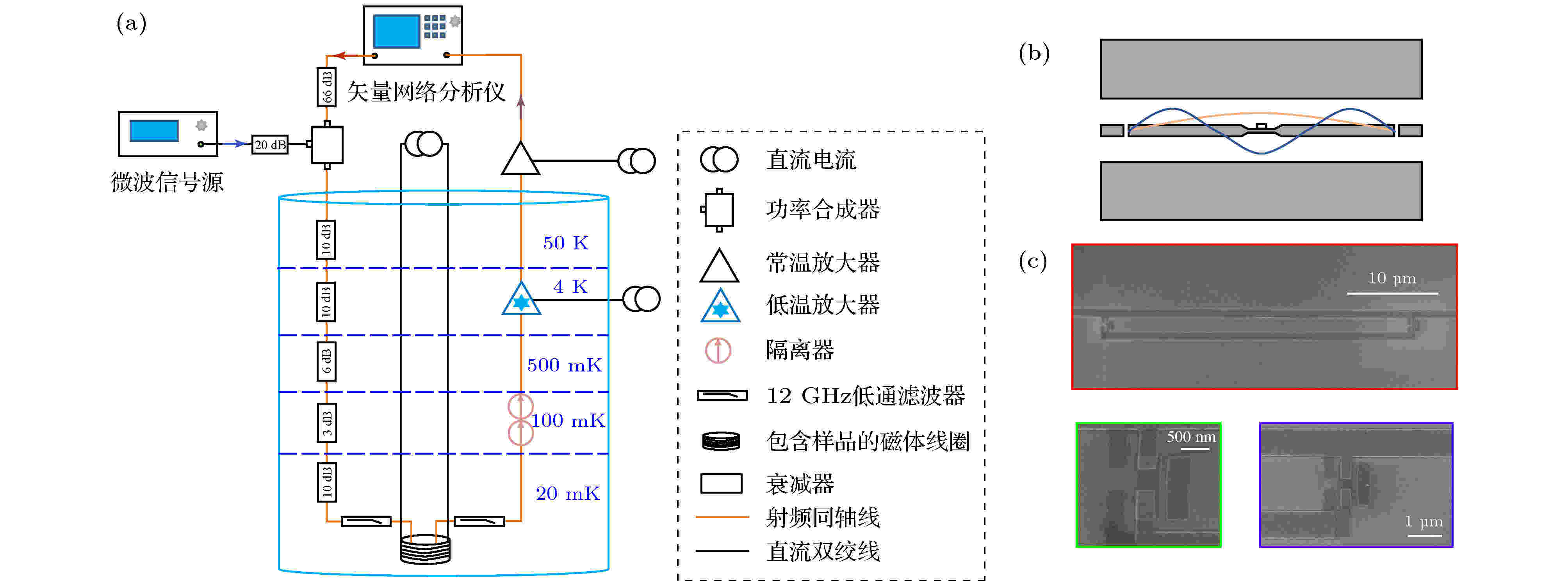
2020, 69 (12): 124204.
doi: 10.7498/aps.69.20200474
Abstract +
In recent years, quantum Rabi model has aroused considerable interest because of its fundamental importance and potential applications in quantum technologies. For a conventional cavity-quantum-electrodynamic (cavity-QED) system involving the interaction between an atom and photons in a cavity, the atom-photon coupling frequency is much smaller than the transition frequency of the atom and the frequency of the cavity mode. This cavity-QED system is usually described by the Jaynes-Cummings model in which the rotating-wave approximation can be adopted by neglecting the counter-rotating coupling terms in the Hamiltonian of the system. However, by designing the unique structure of the superconducting circuit, the ultrastrong-coupling regime can be achieved in a circuit-QED system in which the counter-rotating coupling terms become as important as the rotating terms. Thus, the rotating-wave approximation cannot be used in the ultrastrongly coupled circuit-QED system. Owing to the ultrastrong coupling, this circuit-QED system is described by the standard quantum Rabi model when a superconducting qubit is coupled only to a single resonator mode. In this work, we experimentally study an ultrastrongly coupled circuit-QED system consisting of a four-junction superconducting flux qubit and a muti-mode coplanar-waveguide resonator. The transmission-spectrum measurement and numerical simulations show that the system is in the ultrastrong-coupling regime. By changing the photon number in the resonator, we observe the frequency shift of the flux qubit via the spectroscopic measurement. This frequency shift contains the contributions from not only the rotating-coupling terms but also the counter-rotating terms, which is in good agreement with the theory. The result indicates that this ultrastrongly-coupled quantum system can be used as a good platform to investigate the quantum Rabi model and has potential applications in various aspects of quantum technology, such as quantum simulation, ultrafast quantum gates, entangled-state preparation and protected qubits.
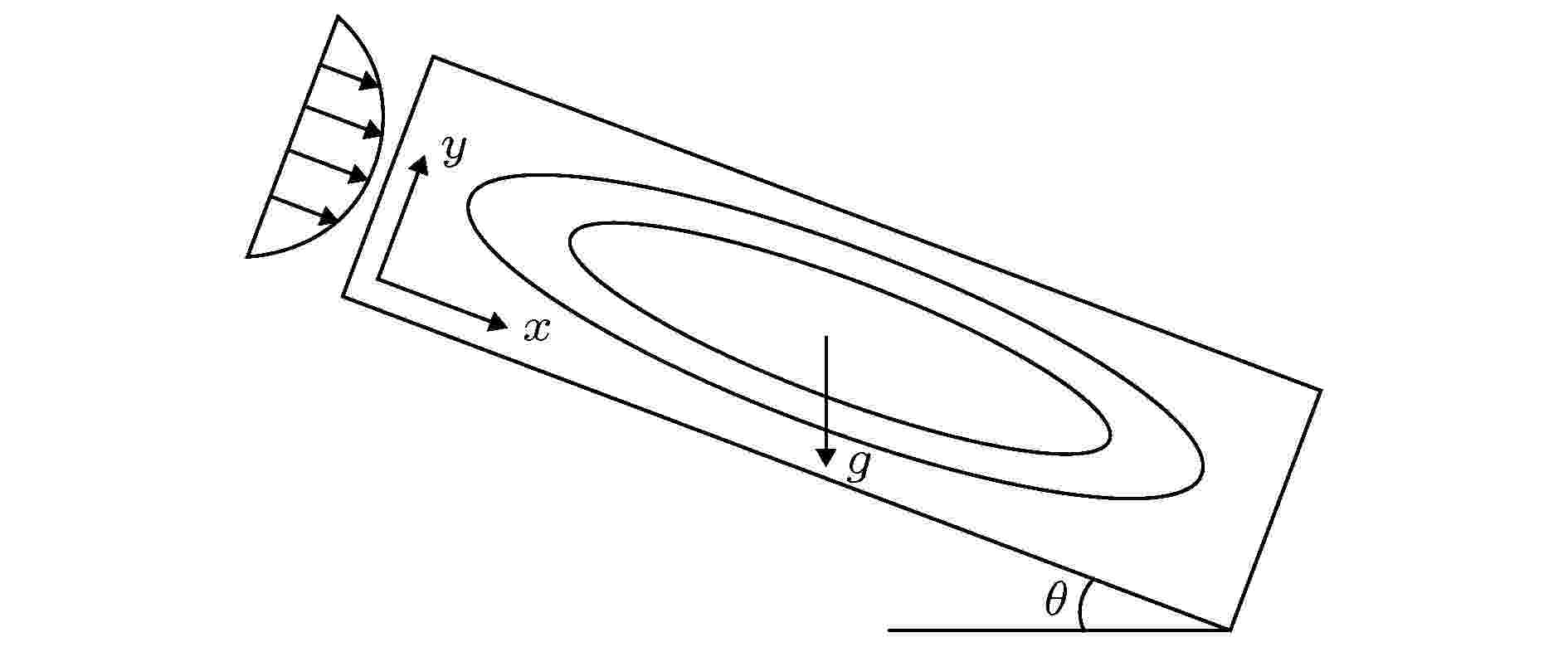
2020, 69 (12): 124401.
doi: 10.7498/aps.69.20191941
Abstract +
Since Henri Bénard first carried out experiments on convection in the fluid layer heated from below at the beginning of last century, and Lord Rayleigh first analyzed small disturbance theoretically, Rayleigh-Bénard convection has received much attention from many researchers, and has become one of the models to study the spatiotemporal structure, flow stability and dynamic characteristics of convection. The methods of studying the Rayleigh-Bénard convection are divided into experimental research, theoretical analysis and numerical simulation. With the development of computer, the research of numerical simulation has made great progress. Because the Rayleigh-Bénard convection can be accurately described by continuity equation, momentum equation and energy equation of hydrodynamics. Therefore, the numerical simulation based on hydrodynamics equations has aroused a lot of research interest. Based on the classical Rayleigh-Bénard convection, the influence of horizontal flow on the Rayleigh-Bénard convection can be studied by applying horizontal flow to one end of the horizontal cavity. On the other hand, the influence of cavity inclination on Rayleigh-Bénard convection can be studied by considering the variation of inclined angles in the cavity. Some valuable convective properties have been obtained. In order to reveal some new convection structures or phenomena, the effects of cavity inclination and through-flow on Rayleigh-Bénard convection are considered at the same time in this paper.By using the numerical simulation of the basic equations of hydrodynamics, the convection partition and dynamic characteristics of the fluid with Prandtl number Pr = 6.99 in the inclined cavity with through-flows are discussed. The results show that for the reduced Rayleigh number r = 9, the system presents uniform traveling wave convection, non-uniform traveling wave convection and single roll convection pattern at the through-flow Reynolds number Re = 1.5 with the increase of the inclined angle θ in the cavity, that for the through-flow Reynolds number Re = 12.5, the system presents the localized traveling wave convection, parallel flow and localized single roll convection pattern with the increase of the inclined angle θ in the cavity, that furthermore, the numerical simulation of different values of through-flow Reynolds number Re and inclined angle θ in the cavity shows that on the plane composed of through flow Reynolds number Re and inclined angle θ in the cavity, the convection in the inclined cavity with through-flow can be divided into six kinds of pattern regions, namely, uniform traveling wave convection region, non-uniform traveling wave convection region, single roll convection region, localized traveling wave convection region, parallel flow region, and localized single roll convection region. The characteristics of the maximum vertical velocity wmax and Nusselt number Nu of convection varying with time in different convection regions are studied. The dynamic properties of convective amplitude A and Nusselt number Nu in different convective regions varying with inclined angle θ in the cavity are discussed.
CONDENSED MATTER: STRUCTURAL, MECHANICAL, AND THERMAL PROPERTIES

2020, 69 (12): 126101.
doi: 10.7498/aps.69.20200204
Abstract +
By introducing redox active substances into electrolyte, the energy density can be effectively increased without reducing the power density. Considering the influence of ionic conductivity and environmental safety, we introduce the redox small molecule hydroquinone (HQ) into the PVA/H3PO4 gel electrolyte, which then will recombine with the carbon nanotube arrays (ACNT) possessing high specific surface area and vertical orientation structure. The symmetrical “sandwich” type redox-enhanced solid-state super capacitor is then designed and prepared. We systematically study the effects of oriented structure and pore space on the electrochemical properties of the ACNT@PVA@HQ device and charge storage mechanism. With the addition of hydroquinone (0.1%, mol%), the specific capacitance of ACNT@PVA@HQ composite device increases 6.4 times compared with that of the ACNT@PVA, and maintains the extremely high rate performance and cyclic stability. When the current density increases 10 times, the specific capacitance of the device still possesses 85% of the original value. The energy storage mechanism is mainly ascribed to a diffusion-control behavior at a low scan rate while it will change into a capacitive behavior at a high scan speed. Furthermore, we prepare highly densified oriented carbon nanotube arrays (DACNT) by solvent evaporation, enhancing the mechanical stability of carbon nanotube arrays and improving the specific capacitance and energy density of the devices. Compared with the specific capacitance of ACNT and random carbon nanotube (CCNT), that of DACNT@PVA@HQ device under the current density of 11.1 mA·cm–2 increases up to 385 mF·cm–2 (1674 mF·cm–3), which is 6.6 times higher than that of the CCNT@PVA@HQ device and 18 times higher than that of the ACNT@PVA device. The maximum energy density can finally reach as high as 0.06 mW·h·cm–2 (0.26 mW·h·cm–3), which is much better than those of many other reported CNTs-based devices. The oriented structure of the arrays effectively shortens the ion migration path of the device, achieving a good rate performance and lower internal resistance. This new type of redox-enhanced solid-state supercapacitor not only has excellent electrochemical energy storage properties, but also meets the requirements for environmental protection and safety. This design provides a new idea for developing the new energy devices in the future, which has a good prospect in practical applications.
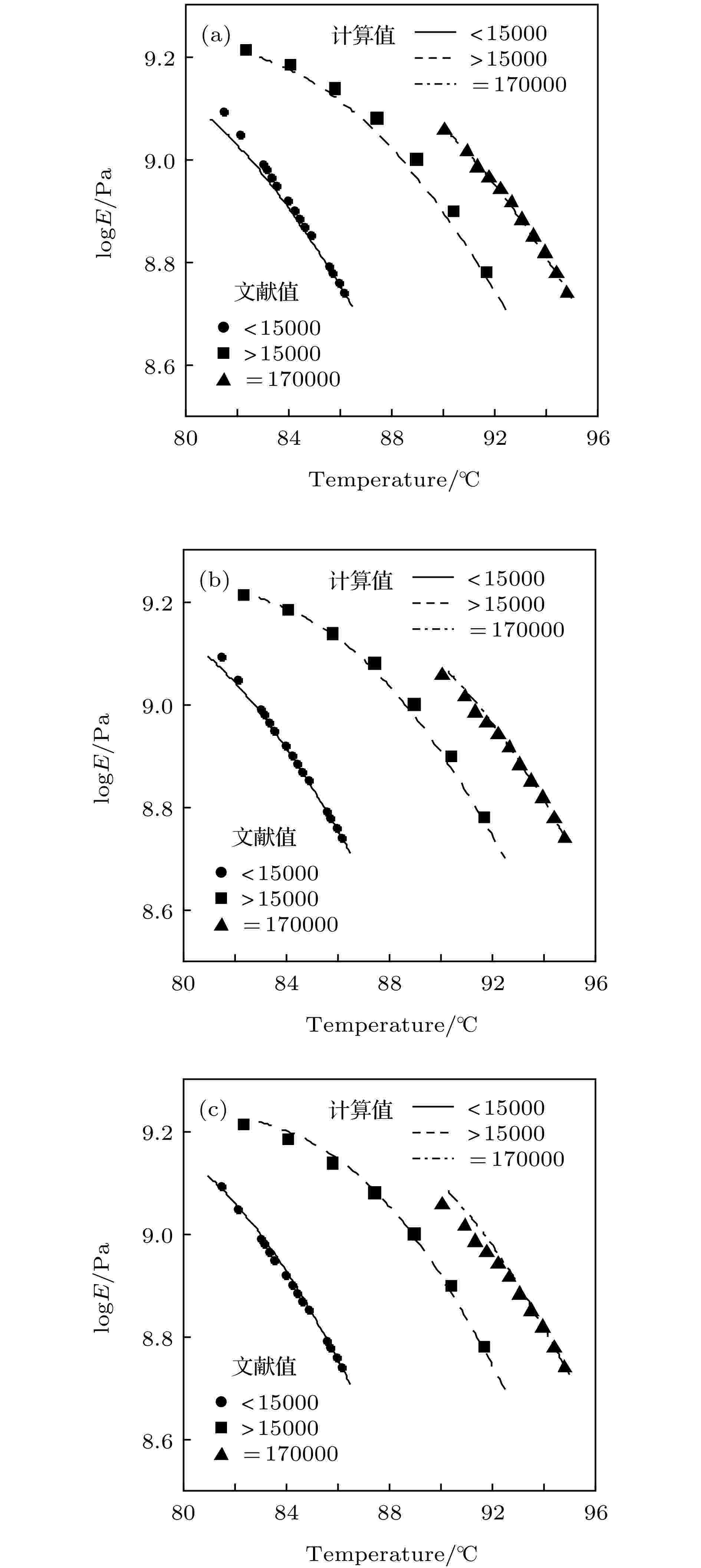
2020, 69 (12): 126401.
doi: 10.7498/aps.69.20200331
Abstract +
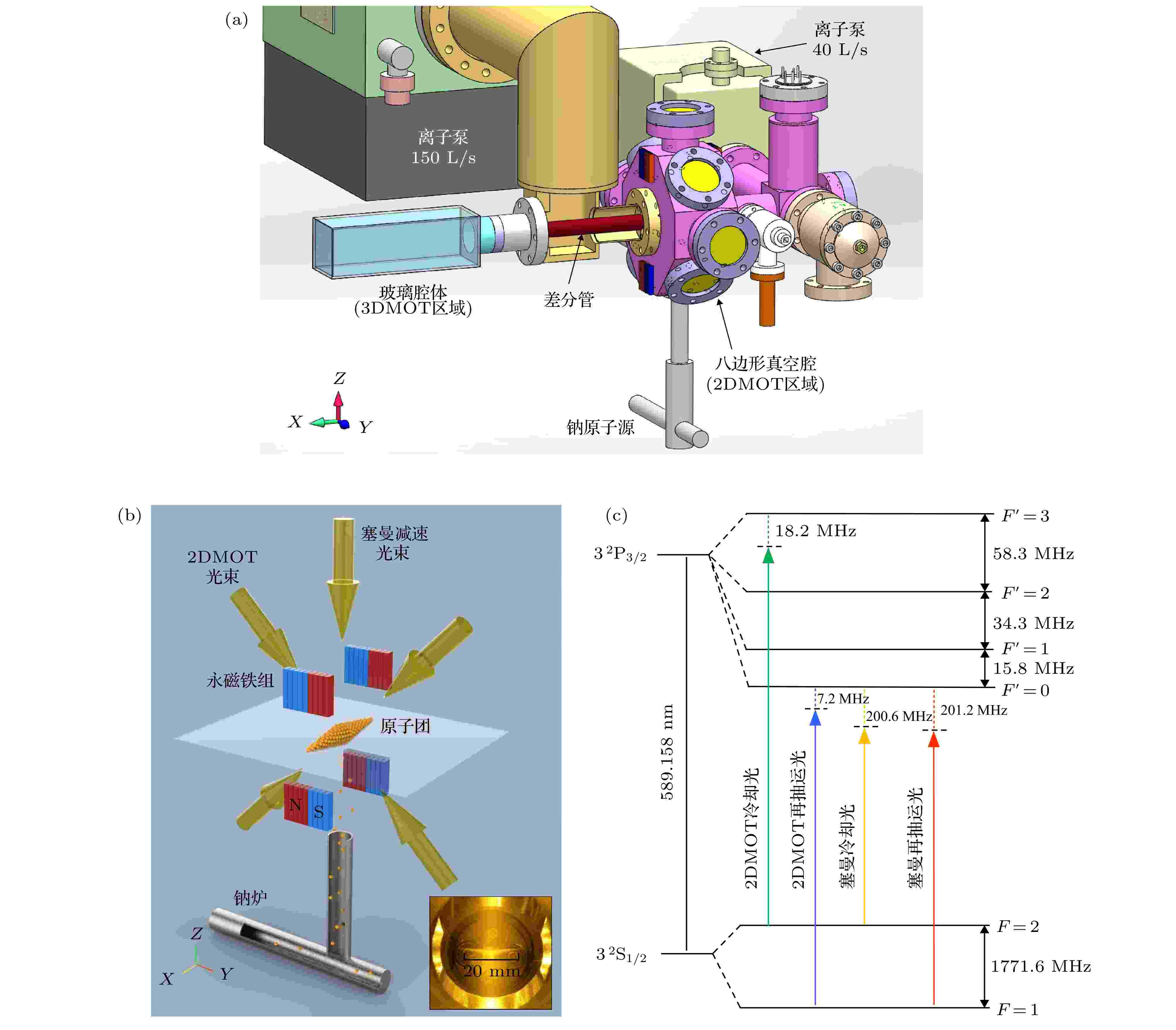
2020, 69 (12): 126701.
doi: 10.7498/aps.69.20200266
Abstract +
It is helpful to make full use of the laboratory space by simplifying the cold atom experimental system, especially in the area of aerospace and precision measurement. We present a two-dimensional magneto-optical trap (2DMOT) for sodium atoms, whose magnetic field is produced by four sets of permanent magnets, and the residual field in the vertical direction is used for a Zeeman slower. The atoms are cooled and trapped in a 2DMOT which provides a highly efficient atomic flux for three-dimensional magneto-optical trap (3DMOT) in a high-vacuum chamber. The maximum 3DMOT loading rate is measured to be 2.3 × 109/s by optimizing the parameters of the Zeeman slower and the 2DMOT. The atom number trapped in 3DMOT is 6.2 × 109. The 2DMOT designed by using permanent magnets has the property of compact structure and simple size, which can be used to cool and trap other neutral atoms.
CONDENSED MATTER: ELECTRONIC STRUCTURE, ELECTRICAL, MAGNETIC, AND OPTICAL PROPERTIES
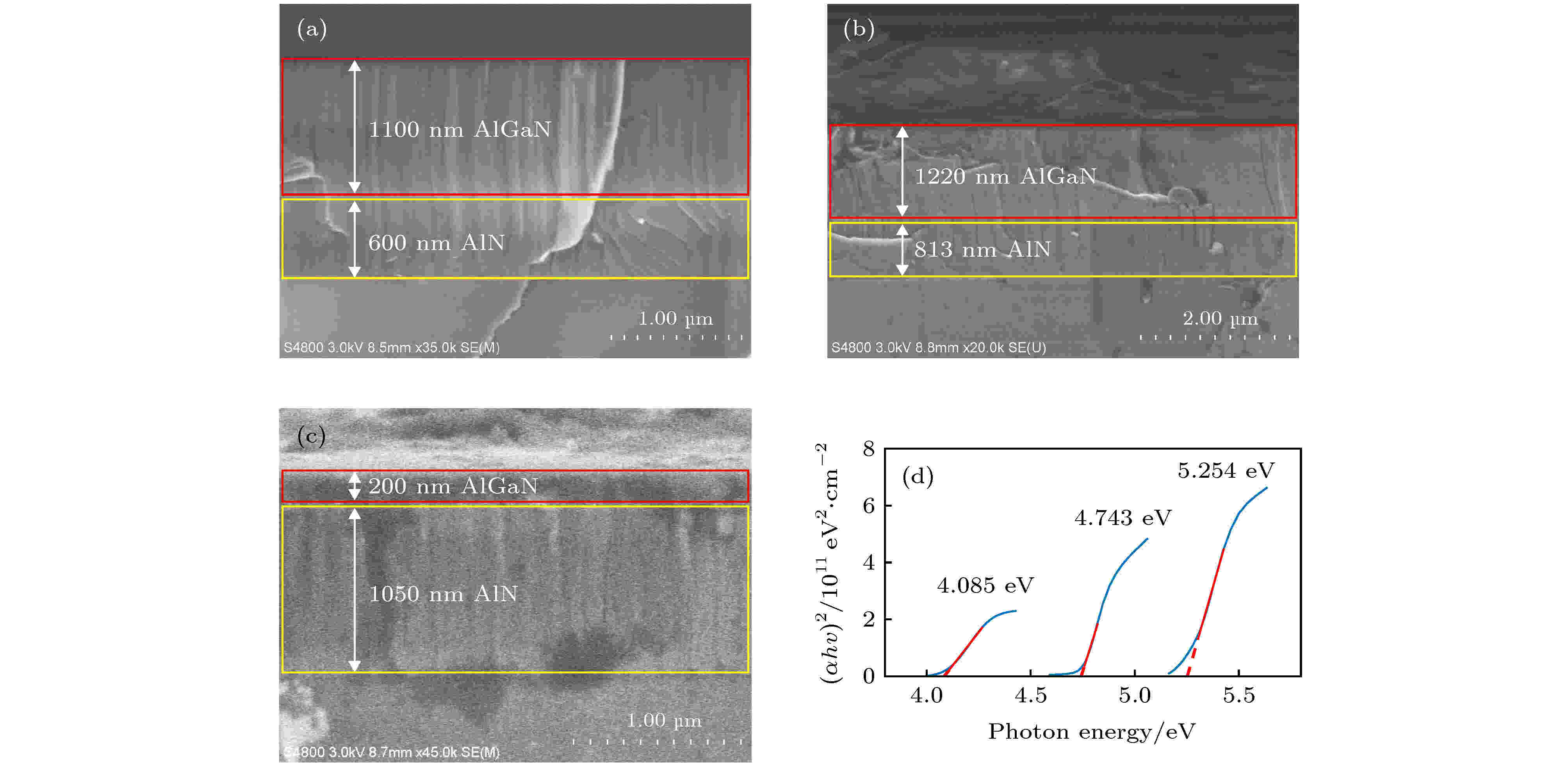
EDITOR'S SUGGESTION
2020, 69 (12): 127302.
doi: 10.7498/aps.69.20200099
Abstract +
AlGaN is a key material for deep ultraviolet optoelectronic and electronic devices. With the increase of the Al composition ratio, the phase separation on the surface, caused by small-scale compositional fluctuations, is prone to affecting the performance of the device. In order to explore the mechanism of the phase separation on a nanoscale, the AlGaN wafers with different quantities of Al compositions are investigated by the confocal photoluminescence spectroscopy and the single-pass Kelvin force probe microscopy. The composition ratios of Al for the three samples are about 0.3, 0.5, and 0.7, respectively. The single-pass Kelvin force probe microscopy based on dual-frequency phase-locking is used to obtain high spatially resolved (about 10 nm) surface potential images. In the area where the phase separation phenomenon is obvious in the photoluminescence spectrum, the sharp change of the surface potential can be observed at the irregular steps and the edges of the surface pits. The potential changes can be ascribed to the inhomogeneous composition distribution. In the area where the topography turns into step flow, the surface pits shrink and merge. No obvious surface potential domain boundaries appear at the steps nor on the edges of the surface pits. Meanwhile, the phase separation phenomenon in the photoluminescence spectrum almost disappears. Our experiments show that the steps and the edges of the surface pits on AlGaN surfaces are main reasons for small-scale compositional fluctuations and the phase separation in the spectrum. Combining with in-situ confocal photoluminescence spectra, high spatially resolved surface potential image by single-pass Kelvin force probe microscopy is an effective method to characterize the phase separation on AlGaN surface on a nanoscale.
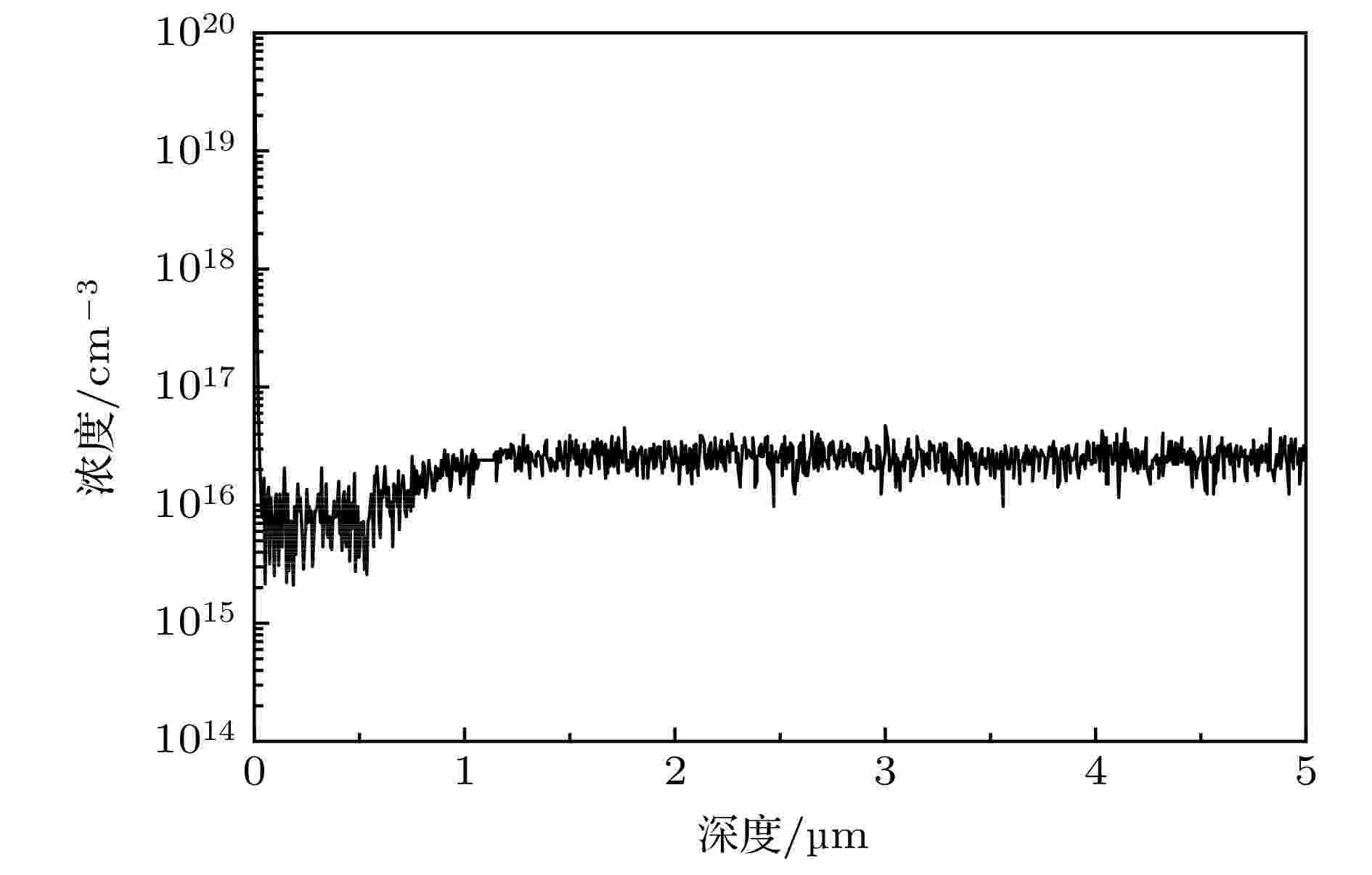
2020, 69 (12): 127802.
doi: 10.7498/aps.69.20200395
Abstract +
Diamond, a wide band gap semiconductor material, has been attracting interest in several fields from electrics and optics to biomedicine and quantum computing due to its outstanding properties. These properties of diamond are related to its unique lattice and optically active defect centers. In this paper, the dependence of nitrogen-vacancy (NV) center on measurement temperature is studied by using the low-temperature photoluminescence (PL) spectroscopy in a temperature range of 80–200 K. The results show that with the increase of the measurement temperature, the zero phonon lines of NV defects are red-shifted, its intensity decreases and its full width at half maximum increases. These results are attributed to the synergetic process of the lattice expansion and quadratic electron-phonon coupling. The NV— and NV0 centers have similar values in the quenching activation energy and the thermal softening coefficient, resulting from their similar structures. The small differences may be associated with the electron-phonon coupling. The broadening mechanism of the NV centers is carefully distinguished by $T^3,\; T^5,\; T^7$ Voigt function fitting with the relation. These results show that the full width at half maximum of the Gaussian component of NV— and NV0 centers are randomly distributed near 0.1 meV and 2.1 meV, respectively, while the full width at half maximum of the Lorentz component of NV— and NV0 centers increase with measurement temperature increasing. The full width at half maximum of Lorentz of NV— and NV0 centers conform to the $ T^3 $ relationship. It can be proved that under the action of the fluctuating field, the zero phonon lines of the NV defects exhibit an obvious homogeneous widening mechanism.
INTERDISCIPLINARY PHYSICS AND RELATED AREAS OF SCIENCE AND TECHNOLOGY
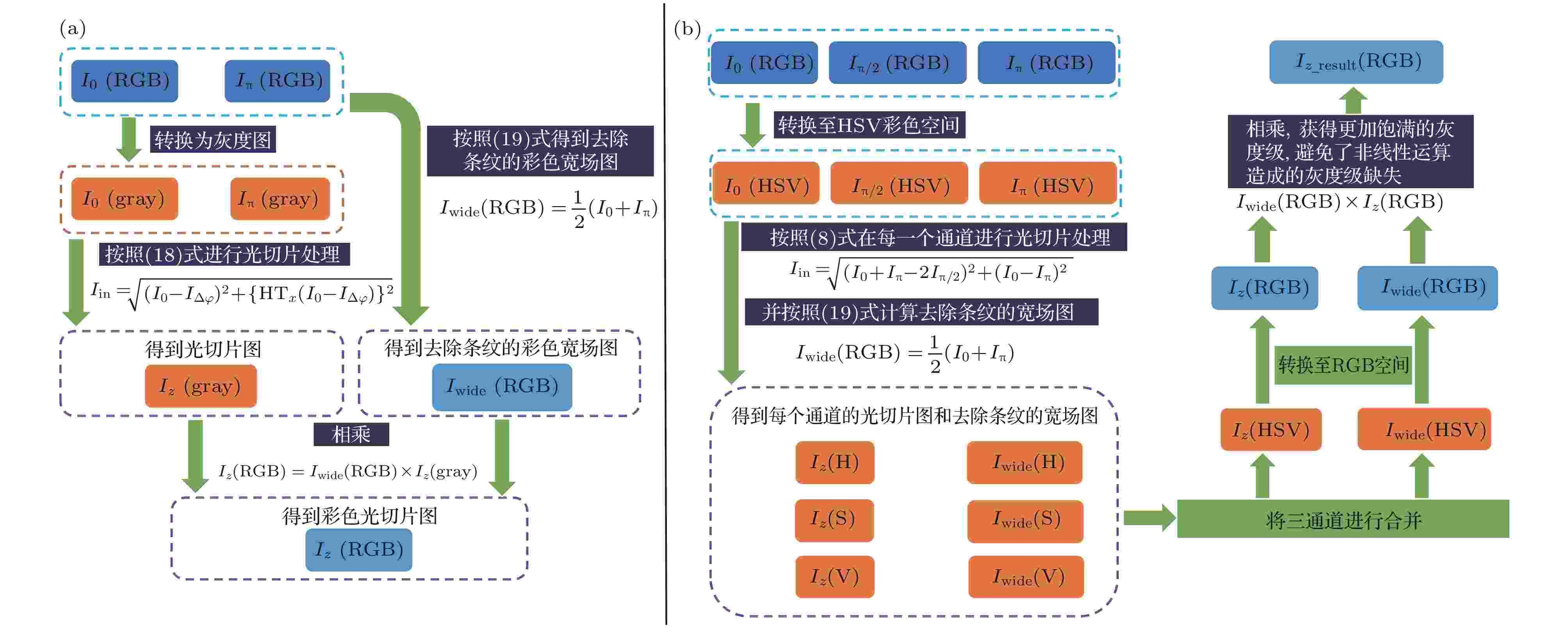
EDITOR'S SUGGESTION
2020, 69 (12): 128701.
doi: 10.7498/aps.69.20200352
Abstract +
As a wide-field microscopy, structured illumination microscopy (SIM) enables super-resolution and three-dimensional (3D) imaging. It has recently received lots of attention due to the advantages of high spatial resolution, short image recording time, and less photobleaching and phototoxicity. The SIM has found numerous important applications in time-lapse imaging of living tissues and cellular structures in the field of biomedical science. Color information is an important physical quantity describing the characteristics of living creatures and reflects the differences in its microstructure and optical property to some extent. Although HSV (hue, saturation, value) color space based structured illumination full-color 3D optical sectioning technique can recover the full color information on the surface of the samples without color distortion. However, for each optical sectioning, three raw images with fixed phase shift are required to calculate the sectioning images by the rootmean square (RMS) algorithm. This will dramatically increase the data acquisition time and data storage space, especially for a large-scaled sample that needs image stitching strategy. The image processing progress operated in HSV color space need to run the RMS algorithm three times in each channel of HSV space for every section, and transform the images between RGB (red-green-blue) space and HSV space twice. This will absolutely extend the data processing time and put forward higher requirements for computer hardware and software for data storage and processing. To this end, in this paper, a fast 3D color optical sectioning SIM algorithm based on Hilbert-transform is proposed. The Hilbert-transform has proved to be a powerful tool in digital signal and image processing and has successfully applied to the SIM. Here, only two raw images with structured illumination are needed to reconstruct a full-color optical sectioned image for each slice. This fast 3D color sectioning method has the advantage of insensitivity to phase-shift error and has better adaptability to noise, high quality color sectioning images can be obtained under the phase-shift error or noise disturbed environment. The image acquisition data are reduced by 1/3 and the color optical sectioning reconstruction time is saved by about 28%, this new method effectively improves the efficiency and speed for 3D color imaging and will bring a wider application range for SIM.


































